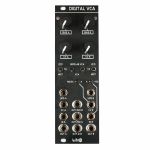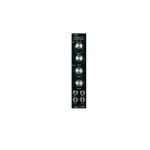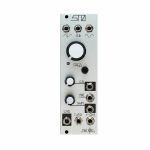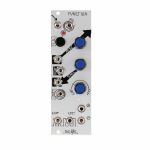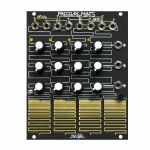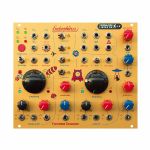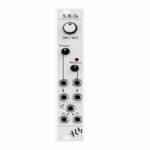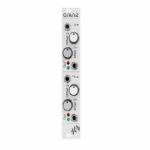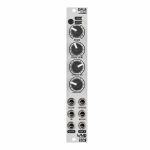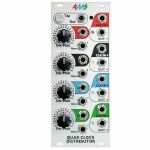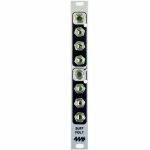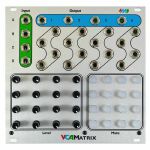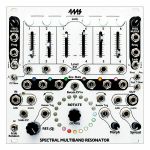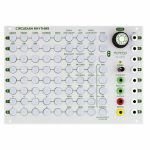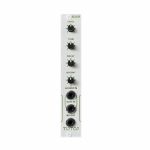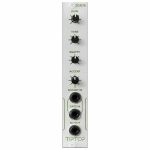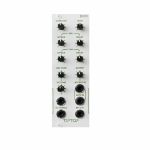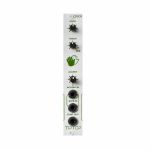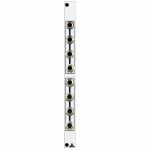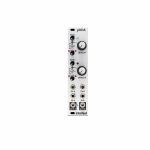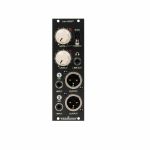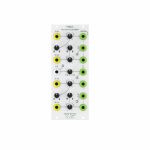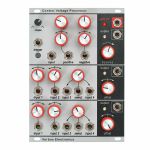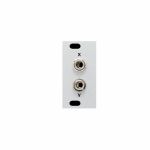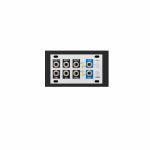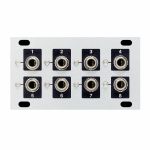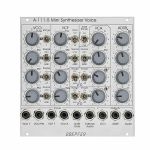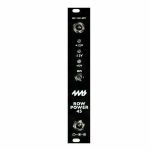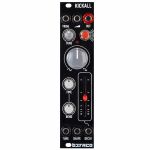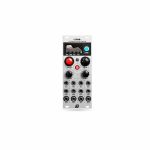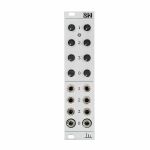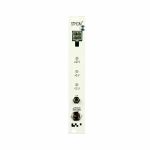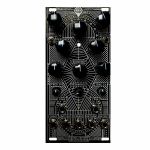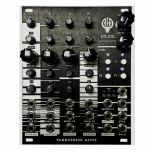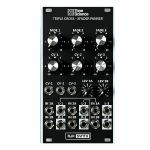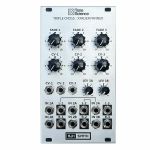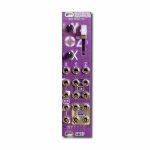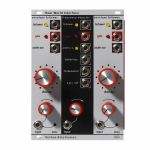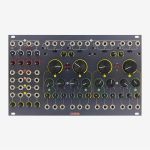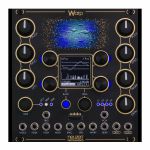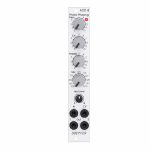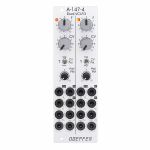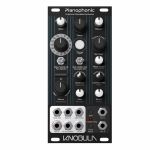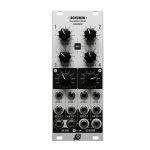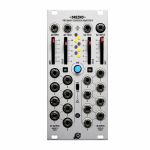安全なお買い物
Studio equipment
Our full range of studio equipment from all the leading equipment and software brands. Guaranteed fast delivery and low prices.
安全なお買い物
DJ equipment
Our full range of DJ equipment from all the leading equipment and software brands. Guaranteed fast delivery and low prices. Visit Juno DJ
Filter
Synth modules
The Eurorack modular synth format is one of the most exciting areas of music technology. Pioneered by Doepfer, there are now hundreds of brands offering compatible modules of all varieties. You can combine your choice of the best oscillators, filters and much more in order to create a unique, bespoke synth setup which perfectly suits your needs.
Eurorack modules offer the biggest range of options you can imagine, from basic analogue modules which replicate the sound of classic vintage synths, through to digital modules which allow you to explore completely new approaches to making music.
Whether you’re a beginner or a more experienced modular head, you can take your pick of the best modules from leading brands including Mutable Instruments and ALM Busy Circuits.
Our range also includes accessories, cases, patch cables and much more, allowing you to build and customise your perfect modular synth setup.

WMD Digital VCA MKIII Dual Zero-Crossing VCA & Polariser Module (polariser/ring modulator/sample & hold/VCA module)
Cat: 1008017 Rel: 27 Mar 24
Dual digital VCA module with zero crossing detection, polarisation, noise, sample & hold - 8HP
Notes: Another update for WMD's clever dual VCA, this time a little bigger to give more control. Digital control of CV and attenuation gives lots of creative options. Third time's a charm.
Supplier's Notes:
WMD have done several designs of this circuit over the years, the first one had no knobs, the second was too small, the MKIII is finally how this circuit should be packaged. This module does some really cool stuff and is super useful in any system.
The Digital VCA lets signal through like a normal VCA, but the CV and attenuation level is controlled digitally. This lets us do things like wait until there is a zero crossing to change the amplitude, resulting in clickless amplitude changes.
The Trigger mode causes the VCA to only update when a trigger is received. The addition of a noise circuit for each side let us do a very quick and easy sample and hold that never droops. With no input, 5V is normaled to the attenuator, so you get a 0-5V sample and hold. In Bipolar mode, you can get -5 to +5V.
Both sides have bipolar VCA mode (polarizer), which lets them invert the signal when negative CV comes in. Also known as ring modulation. With the zero crossing detector, this can produce some super wild wave shapes.
Features
Dual VCA Design
Unipolar or Bipolar Operation
DC Coupled Analogue Signal Path
Low Distortion / Low Noise
VCA Closes Completely
Zero Crossing Detector Mode
Trigger Mode
Two Independent Noise Sources
8 bit CV resolution
Great for Fast Envelopes and Sine Bass Sounds
Specifications
Power: +65mA, -45mA
Width: 8HP
Depth: 35mm with cables
Height: Eurorack 3U (128.5mm)
Board Height Behind Panel: 112mm
CV/Signal Input Impedance: 100k
Output Impedance: 1k
UPD in 3.3V Threshold Schmitt Trigger
ZCD produces 15us 5V pulse
5V CV to fully open VCA
Linear VCA response
20Vpp signal handling
… Read moreSupplier's Notes:
WMD have done several designs of this circuit over the years, the first one had no knobs, the second was too small, the MKIII is finally how this circuit should be packaged. This module does some really cool stuff and is super useful in any system.
The Digital VCA lets signal through like a normal VCA, but the CV and attenuation level is controlled digitally. This lets us do things like wait until there is a zero crossing to change the amplitude, resulting in clickless amplitude changes.
The Trigger mode causes the VCA to only update when a trigger is received. The addition of a noise circuit for each side let us do a very quick and easy sample and hold that never droops. With no input, 5V is normaled to the attenuator, so you get a 0-5V sample and hold. In Bipolar mode, you can get -5 to +5V.
Both sides have bipolar VCA mode (polarizer), which lets them invert the signal when negative CV comes in. Also known as ring modulation. With the zero crossing detector, this can produce some super wild wave shapes.
Features
Dual VCA Design
Unipolar or Bipolar Operation
DC Coupled Analogue Signal Path
Low Distortion / Low Noise
VCA Closes Completely
Zero Crossing Detector Mode
Trigger Mode
Two Independent Noise Sources
8 bit CV resolution
Great for Fast Envelopes and Sine Bass Sounds
Specifications
Power: +65mA, -45mA
Width: 8HP
Depth: 35mm with cables
Height: Eurorack 3U (128.5mm)
Board Height Behind Panel: 112mm
CV/Signal Input Impedance: 100k
Output Impedance: 1k
UPD in 3.3V Threshold Schmitt Trigger
ZCD produces 15us 5V pulse
5V CV to fully open VCA
Linear VCA response
20Vpp signal handling
1 in stock $234.57
Click for better price!
or call +44 20 7424 1960
quote 1008017
quote 1008017
Eowave Zone BF Dual LFO Module With 16 Waveforms (clock generator/dual/stereo/LFO/CV modulation module)
Cat: 553624 Rel: 19 Nov 14
Dual low frequency oscillator module - 5HP
Notes: The ZONE B.F. module is an element of the Capsule TITAN. Zone basses frequences stands for low frequency zone. This module is composed of 2 LFOs, both LFOs have 16 sync-able waveforms.
Speed : speed of the LFO, range from 0.1 Hz to +/-200 Hz
Wave (LFO 1 & 2) : 16 Syncable waveforms
The ZONE B.F. (black edition onwards) now features an additional mode. On the back of the PCB you will find two jumpers, marked as JP1. CV1 is LFO channel 1 and CV2 is LFO channel 2. By moving the jumper so it sits on one leg (rather than 2 as when you have received the module), the Sync input for either LFO channel now becomes LFO speed input, controllable via CV.
Tech Specs
- SYNC 1 & 2 : LFO waveform is reset when an impulse signal is received
- OUT 1 & 2 : LFO signal outputs 1 & 2
- Voltage swing is -/+5V
- LEDs display LFO activity
- Eurorack 5 HP
- Metal pot, panel mounted, screwed
- Consumption: +12V 40mA, -12V 10mA
… Read moreSpeed : speed of the LFO, range from 0.1 Hz to +/-200 Hz
Wave (LFO 1 & 2) : 16 Syncable waveforms
The ZONE B.F. (black edition onwards) now features an additional mode. On the back of the PCB you will find two jumpers, marked as JP1. CV1 is LFO channel 1 and CV2 is LFO channel 2. By moving the jumper so it sits on one leg (rather than 2 as when you have received the module), the Sync input for either LFO channel now becomes LFO speed input, controllable via CV.
Tech Specs
- SYNC 1 & 2 : LFO waveform is reset when an impulse signal is received
- OUT 1 & 2 : LFO signal outputs 1 & 2
- Voltage swing is -/+5V
- LEDs display LFO activity
- Eurorack 5 HP
- Metal pot, panel mounted, screwed
- Consumption: +12V 40mA, -12V 10mA
2 in stock $100.67
Make Noise STO Voltage Controlled Compact Oscillator Module (oscillator synth module)
Cat: 557453 Rel: 19 Dec 14
Compact voltage controlled oscillator (VCO) module specifically designed for generating SINE waves
Notes: A compact Voltage Controlled Oscillator designed for generating SINE waves, Variable wave-SHAPEs, SUB-Octaves, Oscillator SYNC and Linear FM in the analog domain.
The Sub-Timbral Oscillator is the more subtle and melodic friend to the DPO's complex harmonic lattice.
… Read moreThe Sub-Timbral Oscillator is the more subtle and melodic friend to the DPO's complex harmonic lattice.
2 in stock $183.28
Make Noise Function Function Generator Module (envelope generator/LFO/sample and hold/slew limiter/envelope follower/function generator module)
Cat: 557477 Rel: 19 Dec 14
Function generator module - 8HP
Notes: The FUNCTION music synthesizer module is part of the MATHS family of control voltage utility modules. It is a small analog computer designed for solely musical purposes.
Features:
Generate a variety of linear, logarithmic, or exponential functions
Functions as short as 2ms and as long as 25 minutes per cycle!
Triggered Functions (Envelope)
Continuous Functions (LFO)
Invert and/ or Integrate (Lag, Slew, Portamento)
Discrete Time Functions (S&H, T&H)
LEDs indicate activity on all outputs
End of Rise and End of Cycle Pulses facilitate programming of more complex functions
All outputs capable of driving a passive 4 way mult without loading effects (no buffered mult needed here)
Perfect for modulating the DPO and just about anything else
Specifications:
Width: 8hp
Max Depth
(incl. power cable): 32mm
Power:
30mA@ +12V
20mA @ -12V
… Read moreFeatures:
Generate a variety of linear, logarithmic, or exponential functions
Functions as short as 2ms and as long as 25 minutes per cycle!
Triggered Functions (Envelope)
Continuous Functions (LFO)
Invert and/ or Integrate (Lag, Slew, Portamento)
Discrete Time Functions (S&H, T&H)
LEDs indicate activity on all outputs
End of Rise and End of Cycle Pulses facilitate programming of more complex functions
All outputs capable of driving a passive 4 way mult without loading effects (no buffered mult needed here)
Perfect for modulating the DPO and just about anything else
Specifications:
Width: 8hp
Max Depth
(incl. power cable): 32mm
Power:
30mA@ +12V
20mA @ -12V
3 in stock $178.52
Click for better price!
or call +44 20 7424 1960
quote 557477
quote 557477
Make Noise Pressure Points Analogue Touch Controller/Manual Sequencer Module (controller/sequencer synth module)
Cat: 557510 Rel: 19 Dec 14
Controller/analog sequencer module that is played by hand
Notes: Pressure Points is a controller module, an analog sequencer that is played by hand. Touching the gold plated copper wires (aka Touch Plates), you become part of the circuit, generating a gate signal (Gate OUT), a control signal proportional to the amount of pressure applied (Press OUT) and the 3 Tuned Voltages for the activated Stage.
… Read more 1 in stock $202.39
Endorphin.es Furthrrrr Generator Dual Complex VCO Module With Waveshaper (yellow) (oscillator/dual/stereo/function generator/LFO/noise/random module)
Cat: 579172 Rel: 07 Aug 15
Dual voltage controlled oscillator module with waveshaper module - 30HP
Notes: The Furthrrrr Generator has a main oscillator (carrier) with an extensive and fully voltage controllable wave multiplier and a modulation oscillator (modulator) that can cross-modulate the carrier. Each oscillator has hard and soft sync and also features an integrated tuner: if both LEDs are lit the VCO is at note A. Left LED is lit at note Ab and right LED at A#. Frequency potentiometers are ten-turn models and thus allow for easy tuning. Frequency range of the VCOs is 10Hz-10kHz (and much lower in modulator's LFO mode). Both VCOs feature 2 frequency CV inputs (1x with bipolar attenuator, 1x with 1V/octave), one FM input (jumper selectable between linear and exponential FM) as well as separate input for hard and soft sync. The voltage characteristic can be selected between 1V/octave and 1.2V/octave (Buchla norm).
The main oscillator (carrier) outputs the waveforms sine, saw, square and white noise. The two outputs marked with the magic eye are outputs of the "harmonic section" that generates very complex sounds by the wave multiplier and its parameters symmetry, order and Furthrrrr in the module's right-hand section. Symmetry lowers the level of even harmonics and amplifies the odd harmonics (this affects the pulse wave's width as well). Order adds saturation to the high order harmonics and resembles a low pass filter. Furthrrrr alters the level of harmonics set by the other parameters and produces very interesting, partly brute sounds with lots of harmonics by clipping and folding the wave. All three parameters can be voltage controlled. The carrier oscillator also has inputs for hard and soft sync, the sync-switch can synch directly to the modulator.
The modulation oscillator (modulator) has three wave forms with direct outputs: sine, saw and square. Using the internal modulation via the "mood section" the waveform is selected with a button; an additional staircase wave form is available here, but it can be overridden by inserting a signal into the external input socket. A switch activates the LFO mode.
The Mood section is responsible for the internal modulation of the carrier by the modulator. Switches determine the modulation destination(s) that can be activated simultaneously. These are the Furthrrrr parameter of the harmonic section, the amplitude and the frequency of the carrier oscillator. The "balanced" switch activates the ring modulation between both VCOs. intensity of modulation is controlled by the "mood index" potentiometer and the according CV input with bipolar attenuator.
… Read moreThe main oscillator (carrier) outputs the waveforms sine, saw, square and white noise. The two outputs marked with the magic eye are outputs of the "harmonic section" that generates very complex sounds by the wave multiplier and its parameters symmetry, order and Furthrrrr in the module's right-hand section. Symmetry lowers the level of even harmonics and amplifies the odd harmonics (this affects the pulse wave's width as well). Order adds saturation to the high order harmonics and resembles a low pass filter. Furthrrrr alters the level of harmonics set by the other parameters and produces very interesting, partly brute sounds with lots of harmonics by clipping and folding the wave. All three parameters can be voltage controlled. The carrier oscillator also has inputs for hard and soft sync, the sync-switch can synch directly to the modulator.
The modulation oscillator (modulator) has three wave forms with direct outputs: sine, saw and square. Using the internal modulation via the "mood section" the waveform is selected with a button; an additional staircase wave form is available here, but it can be overridden by inserting a signal into the external input socket. A switch activates the LFO mode.
The Mood section is responsible for the internal modulation of the carrier by the modulator. Switches determine the modulation destination(s) that can be activated simultaneously. These are the Furthrrrr parameter of the harmonic section, the amplitude and the frequency of the carrier oscillator. The "balanced" switch activates the ring modulation between both VCOs. intensity of modulation is controlled by the "mood index" potentiometer and the according CV input with bipolar attenuator.
2 in stock $604.06
Click for better price!
or call +44 20 7424 1960
quote 579172
quote 579172
WMD PDO MKII Phase Displacement Oscillator Module (LFO/oscillator synth module)
Cat: 580280 Rel: 29 Jul 15
Phase Displacement Oscillator (PDO) synth module with analog sawcore VCO - 16HP wide
Notes: The MKII version of the PDO is available: Better CV handling, 16 HP, single PCB instead of stacked boards. An upgrade path is available for those with MKI versions, contact us for more information.
Introducing the WMD Phase Displacement Oscillator (PDO). This hybrid VCO has all the feel of an analog VCO but with the benefits of digital waveshaping. The PDO will easily find a home in your system!
The PDO exists to utilize the phenomenon of Phase Modulation (PM). This allows for the relative phase difference of its outputs to be set or modulated, producing very interesting sounds. The result is similar to Frequency Modulation (FM) but affects the output to a greater degree without affecting the stability of the initial frequency. This is where the "displacement" comes in.
When you use frequency stable phase displacement, you create phase distortion which sounds like wavefolding and is very useful for dynamic textures and powerful sounds.
PM has the same benefits of quadrature filters/sine wave generators and greatly exceeds their capabilities at audio rate modulations. PM is highly useful for for creating metallic and bell tones and very controlled harmonic interactions.
Because PM affects the relative phase and not the frequency of the waveform generated, the PDO can self modulate its PM inputs. This creates complex harmonic signals that seem to vary in frequency but are quite stable.
Phase Modulation is also quite powerful when using the PDO as an LFO. Adjusting the relative phase of each output allows for very precise modulation of other modules. Each output can have any of the available waveforms simultaneously. There is a myriad of modulation possible with the PDO!
… Read moreIntroducing the WMD Phase Displacement Oscillator (PDO). This hybrid VCO has all the feel of an analog VCO but with the benefits of digital waveshaping. The PDO will easily find a home in your system!
The PDO exists to utilize the phenomenon of Phase Modulation (PM). This allows for the relative phase difference of its outputs to be set or modulated, producing very interesting sounds. The result is similar to Frequency Modulation (FM) but affects the output to a greater degree without affecting the stability of the initial frequency. This is where the "displacement" comes in.
When you use frequency stable phase displacement, you create phase distortion which sounds like wavefolding and is very useful for dynamic textures and powerful sounds.
PM has the same benefits of quadrature filters/sine wave generators and greatly exceeds their capabilities at audio rate modulations. PM is highly useful for for creating metallic and bell tones and very controlled harmonic interactions.
Because PM affects the relative phase and not the frequency of the waveform generated, the PDO can self modulate its PM inputs. This creates complex harmonic signals that seem to vary in frequency but are quite stable.
Phase Modulation is also quite powerful when using the PDO as an LFO. Adjusting the relative phase of each output allows for very precise modulation of other modules. Each output can have any of the available waveforms simultaneously. There is a myriad of modulation possible with the PDO!
1 in stock $402.71
Click for better price!
or call +44 20 7424 1960
quote 580280
quote 580280
ALM Beast's Chalkboard Octave Switcher/Voltage Adder Module (utility/multiple synth module)
Cat: 584248 Rel: 15 Apr 16
Dual channel stepped voltage source and adder synth module - 6HP wide
Notes: 'Beast's Chalkboard' is dual channel stepped voltage source and adder for your eurorack modular synthesizer system. It primarily is intended as a dual octave switcher for VCO's but has many other uses including sequence transposition, FM ratio creation, buffered CV distribution and VCO calibration.
Technical Specifications:
Supply: +/-12V (Reverse voltage & polyfuse protection)
Current Draw: ~30ma
Size: 6 HP
Depth: 22mm (including power header)
Offset Error: +/- 10mV
… Read moreTechnical Specifications:
Supply: +/-12V (Reverse voltage & polyfuse protection)
Current Draw: ~30ma
Size: 6 HP
Depth: 22mm (including power header)
Offset Error: +/- 10mV
2 in stock $112.08
Click for better price!
or call +44 20 7424 1960
quote 584248
quote 584248
ALM SBG Guitar Effects Pedals Interface Module (attenuator/external/utility/mixer synth module)
Cat: 584253 Rel: 15 Apr 16
Compact utility synthesiser module for interfacing guitar effects with eurorack modular system - 4HP wide
Notes: The 'S.B.G' is a compact utility module intended for the interfacing of guitar effect pedals with your eurorack modular system.
It provides both attenuation and amplification of audio signals for level matching together with a crossfade control to conveniently adjust the wet/dry mix of a processed signal. The module also offers regulation of outgoing CV signals for safer use of pedal expression inputs.
Technical Specifications:
Supply: +/-12V (Reverse voltage protection)
Current Draw: ~30ma
Size: 4 HP
Depth: 22mm (including power header)
… Read moreIt provides both attenuation and amplification of audio signals for level matching together with a crossfade control to conveniently adjust the wet/dry mix of a processed signal. The module also offers regulation of outgoing CV signals for safer use of pedal expression inputs.
Technical Specifications:
Supply: +/-12V (Reverse voltage protection)
Current Draw: ~30ma
Size: 4 HP
Depth: 22mm (including power header)
4 in stock $95.48
Click for better price!
or call +44 20 7424 1960
quote 584253
quote 584253
ALM O/A/x2 Dual Channel Offset & Attenuverter Module (atenuator/dual/stereo/mixer/polarizer/utility synth module)
Cat: 584260 Rel: 15 Apr 16
Dual channel attenuverter synthesiser module - 4HP
Notes: 'O/A/x2' is a dual channel attenuverter with each channel also including a bipolar voltage offset and LED monitoring. The module is primarily intended for fine grain flexible 'editing' of control signals (i.e changing the phase, level and DC offset of an LFO signal) but also has uses with audio signals such as attenuation, inversion and mixing.
Technical Specifications:
Supply: +/-12V (Reverse voltage protection)
Current Draw: ~50ma
Size: 4 HP
Depth: 32mm (including power header)
… Read moreTechnical Specifications:
Supply: +/-12V (Reverse voltage protection)
Current Draw: ~50ma
Size: 4 HP
Depth: 32mm (including power header)
8 in stock $80.43
Click for better price!
or call +44 20 7424 1960
quote 584260
quote 584260
WMD/SSF DPLR Voltage-Controlled Delay & Chorus Module (modular synthesiser)
Cat: 588826 Rel: 02 Oct 15
Voltage-controlled delay & chorus module - 4HP
Notes: DPLR is a delay module with two interactive delay lines, each with 750ms of delay time.
One input is split into two delays which share the total delay time (DELAY) and regeneration (REGEN). Side B has control over its delay offset (SPREAD) from side A.
Delay, Spread and Regen are all voltage controlled. Regen at max will echo indefinitely and can create interesting noise swashes.
The top knob toggles through seven different crosstalk configurations (Regen isolated by ping-pong). Press and hold to cycle through four different Regen Filter settings, from very bright to dark.
Two interactive delay lines
750mS delay time
Voltage controlled parameters
Seven crosstalk configurations
Four regen filter settings
Adjustable wet or wet/dry via jumper setting
Power consumption: 67mA at +12 V and 31mA at -12 V
Depth: 45
4 HP
… Read moreOne input is split into two delays which share the total delay time (DELAY) and regeneration (REGEN). Side B has control over its delay offset (SPREAD) from side A.
Delay, Spread and Regen are all voltage controlled. Regen at max will echo indefinitely and can create interesting noise swashes.
The top knob toggles through seven different crosstalk configurations (Regen isolated by ping-pong). Press and hold to cycle through four different Regen Filter settings, from very bright to dark.
Two interactive delay lines
750mS delay time
Voltage controlled parameters
Seven crosstalk configurations
Four regen filter settings
Adjustable wet or wet/dry via jumper setting
Power consumption: 67mA at +12 V and 31mA at -12 V
Depth: 45
4 HP
1 in stock $186.81
Click for better price!
or call +44 20 7424 1960
quote 588826
quote 588826
4ms Quad Clock Distributor v2 Quad Voltage Controlled Clock Multiplier/Divider Module (clock generator/clock modulator/CV modulation/frequency divider/quad/utility synth module)
Cat: 589490 Rel: 10 Dec 15
4 channel voltage controlled clock divider/multiplier synthesiser module with master tap tempo - 10HP wide
Notes: Four channel voltage controlled Clock Divider/Multiplier with master Tap Tempo. Each channel can be synced to the tap tempo, to the channel above, or to an external clock. Each channel also has a reset jack.
With a Tap Tempo button and five sync'ed clock outputs, the QCD is a versatile head-of-the-chain "Master" clock module, and/or a complex rhythmic pattern generator.
… Read moreWith a Tap Tempo button and five sync'ed clock outputs, the QCD is a versatile head-of-the-chain "Master" clock module, and/or a complex rhythmic pattern generator.
2 in stock $224.18
Click for better price!
or call +44 20 7424 1960
quote 589490
quote 589490
4ms Buff Mult Two Independent 1 To 3 Buffered Mutliples Module (silver) (multiple/video synth module)
Cat: 589492 Rel: 09 Dec 15
Buffered multiple synthesiser module with LED indicators - 3HP wide
Notes: The Buff Mult is a buffered multiple with LED indicators to show positive and negative voltages. Using wide bandwidth opamps, it functions as a dual 1-to-3 or a single 1-to-6 mult for audio, video, or CV signals.
… Read more 2 in stock $75.25
Click for better price!
or call +44 20 7424 1960
quote 589492
quote 589492
4ms VCA Matrix 4-Input & 4-Output VCA Module With 16 Routing Options (mixer VCA synth module)
Cat: 589496 Rel: 10 Dec 15
Playable 4x4 matrix synth module of 16 VCAs - 26HP wide
Notes: The VCA Matrix from 4ms is a playable 4x4 matrix of 16 VCAs.
Four CV or audio inputs can be routed in any amount/combination to four outputs, using the 16 CV control jacks, Level knobs, and Mute buttons.
… Read moreFour CV or audio inputs can be routed in any amount/combination to four outputs, using the 16 CV control jacks, Level knobs, and Mute buttons.
2 in stock $342.50
Click for better price!
or call +44 20 7424 1960
quote 589496
quote 589496
4ms DLD Dual Looping Delay Module (delay/dual/stereo/effect synth module)
Cat: 589504 Rel: 02 Nov 16
Advanced audio processor synthesiser module for creative synthesis - 20HP wide
Notes: Announcing the Dual Looping Delay from 4ms Company, designed by Gary Hall!
The 4ms Dual Looping Delay (or DLD) is an advanced audio processor for creative synthesis. Not a tape or analog emulation but a modern crystal-clear digital delay, the DLD combines features of delay, looping, and sample-tight synchronization for powerful and dynamic sound capture and modification. The DLD is designed to integrate seamlessly with modular time-base and sequencing devices such as the 4ms Quad Clock Distributor (QCD), etc.
What is a "Looping Delay"?
Modern looping devices grew directly from hardware digital delays of the late 70s and early 80s. A looping delay, modelled on units such as the classic Lexicon PCM42, has the very long storage times associated with dedicated looping, but without triggered record and playback functions.
By default, a looping delay records and plays continuously, though recording can be suspended at any time with Infinite Repeat. Sustain of delays and loops is mainly accomplished with regeneration, allowing an organic, evolving approach to sound creation as new material replaces old, more or less gradually. The 4ms Dual Looping Delay also provides advanced clock input and output facilities that allow for locking delayed and looped material with sequencers and rhythm devices of all descriptions.
The 4ms Dual Looping Delay is conceived and designed by Gary Hall. Implemented and manufactured by 4ms Company
… Read moreThe 4ms Dual Looping Delay (or DLD) is an advanced audio processor for creative synthesis. Not a tape or analog emulation but a modern crystal-clear digital delay, the DLD combines features of delay, looping, and sample-tight synchronization for powerful and dynamic sound capture and modification. The DLD is designed to integrate seamlessly with modular time-base and sequencing devices such as the 4ms Quad Clock Distributor (QCD), etc.
What is a "Looping Delay"?
Modern looping devices grew directly from hardware digital delays of the late 70s and early 80s. A looping delay, modelled on units such as the classic Lexicon PCM42, has the very long storage times associated with dedicated looping, but without triggered record and playback functions.
By default, a looping delay records and plays continuously, though recording can be suspended at any time with Infinite Repeat. Sustain of delays and loops is mainly accomplished with regeneration, allowing an organic, evolving approach to sound creation as new material replaces old, more or less gradually. The 4ms Dual Looping Delay also provides advanced clock input and output facilities that allow for locking delayed and looped material with sequencers and rhythm devices of all descriptions.
The 4ms Dual Looping Delay is conceived and designed by Gary Hall. Implemented and manufactured by 4ms Company
1 in stock $393.37
Click for better price!
or call +44 20 7424 1960
quote 589504
quote 589504
4ms Spectral Multiband Resonator Module (filter/envelope follower/digital/oscillator/dual/stereo synth module)
Cat: 589505 Rel: 10 Dec 15
Innovative resonant filter synthesiser module - 26HP
Notes: The Spectral Multiband Resonator from 4ms Company is an innovative resonant filter which can process audio like a classic filter bank, ring like a marimba when plucked/struck, vocode, re-mix tracks, harmonize, output spectral data, quantize audio to scales, and much more...
A gorgeous ring of colored lights displays the frequency of each filter, as well as the levels and current scale selection(s).
At a glance, the SMR works like a normal six-band graphic EQ: six frequency band-pass filters are mixed together using sliders. Resonance/Q is variable, which changes the "ringy-ness" or width of the bands.
But here's where comparison stops. The frequency of each channel is treated like a note in a scale, and the six bands form a chord. Spin the Rotate knob and the "notes" circle around the scale, rotating back to the bottom once they've reached the top. Adjust Spread and the distance (interval) between each note changes. Triggers for up/down motion, CV inputs for sequencing and scale selection allow for flexible control with external modules. Morph, which automatically cross-fades between frequencies, together with variable Slew allows rhythmic clocks drive the SMR as a variable-speed evolving resonant filter.
At maximum Resonance/Q, the SMR can be struck like a gong or marimba by inputting clocks or triggers. The frequency of each channel is quantized to a scale: beautiful chords, ethereal tones and eerie ambiance flows easily. With lower resonance, the SMR can pull out particular frequency bands, and sweep these across the spectrum.
Two 1V/octave Frequency jacks allow for tracking even and/or odd bands and creating floating melodies over evolving chord bases, or complex percussive membrane sounds.
Save your settings into one of six storage banks, and recall on the fly. On startup, the SMR instantly jumps to the last saved settings. The color scheme of the lights can be adjusted, so if you prefer all white lights on your modular, you can have that (or all red, or rainbows, pastels, etc..)!
Advanced features:
- Program your own scale. The frequency of each of the 20 notes can be assigned by setting the octave, the semi-tone, and coarse and fine micro-tone. Up to 11 scales can be saved permanently in the user bank
- Adjust color scheme of the LEDs. Pick a pre-programmed color scheme or create your own using the sliders to set Red/Green/Blue values. Custom color schemes can be saved permanently
- Save your settings in one of six parameter banks. Note position, scale and bank selection, Q value, Lock settings and color scheme can be saved and recalled on the fly. On startup, the SMR loads settings from the last saved bank.
- Optional alternative filter type for a more exponential decay when plucked and different timbral qualities. Freq jacks no longer track 1V/oct in this mode.
- Slider LEDs can be assigned to display level for each channel (combination of slider position and CV on the jack), or clipping for each channel.
… Read moreA gorgeous ring of colored lights displays the frequency of each filter, as well as the levels and current scale selection(s).
At a glance, the SMR works like a normal six-band graphic EQ: six frequency band-pass filters are mixed together using sliders. Resonance/Q is variable, which changes the "ringy-ness" or width of the bands.
But here's where comparison stops. The frequency of each channel is treated like a note in a scale, and the six bands form a chord. Spin the Rotate knob and the "notes" circle around the scale, rotating back to the bottom once they've reached the top. Adjust Spread and the distance (interval) between each note changes. Triggers for up/down motion, CV inputs for sequencing and scale selection allow for flexible control with external modules. Morph, which automatically cross-fades between frequencies, together with variable Slew allows rhythmic clocks drive the SMR as a variable-speed evolving resonant filter.
At maximum Resonance/Q, the SMR can be struck like a gong or marimba by inputting clocks or triggers. The frequency of each channel is quantized to a scale: beautiful chords, ethereal tones and eerie ambiance flows easily. With lower resonance, the SMR can pull out particular frequency bands, and sweep these across the spectrum.
Two 1V/octave Frequency jacks allow for tracking even and/or odd bands and creating floating melodies over evolving chord bases, or complex percussive membrane sounds.
Save your settings into one of six storage banks, and recall on the fly. On startup, the SMR instantly jumps to the last saved settings. The color scheme of the lights can be adjusted, so if you prefer all white lights on your modular, you can have that (or all red, or rainbows, pastels, etc..)!
Advanced features:
- Program your own scale. The frequency of each of the 20 notes can be assigned by setting the octave, the semi-tone, and coarse and fine micro-tone. Up to 11 scales can be saved permanently in the user bank
- Adjust color scheme of the LEDs. Pick a pre-programmed color scheme or create your own using the sliders to set Red/Green/Blue values. Custom color schemes can be saved permanently
- Save your settings in one of six parameter banks. Note position, scale and bank selection, Q value, Lock settings and color scheme can be saved and recalled on the fly. On startup, the SMR loads settings from the last saved bank.
- Optional alternative filter type for a more exponential decay when plucked and different timbral qualities. Freq jacks no longer track 1V/oct in this mode.
- Slider LEDs can be assigned to display level for each channel (combination of slider position and CV on the jack), or clipping for each channel.
1 in stock $429.69
Click for better price!
or call +44 20 7424 1960
quote 589505
quote 589505
Tiptop Audio Circadian Rhythms Step Sequencer Module (white) (clock generator/sequencer/random module)
Cat: 590414 Rel: 05 Apr 16
Step sequencer module - 36HP
Notes: The Circadian Rhythms is moving modular synthesizer technology another step forward by gluing all the pieces of a system together. Each module or voice can now be programmed to play straight from an intelligent, eight-channel, 512-step master trigger sequencer made for composers looking to make music on the modular. Building on the sequencing concept of step programing multi-channel patterns of musical phrases can be repeated, looped, chained, muted and manipulated on the fly in real-time, and most importantly, all of this is done through a simple, clearly labeled interface. Using an array of multicolor illuminated buttons and innovative grid views provides a highly functional live performance sequencer with a beautiful glowing appearance of the programmed music that will look amazing on stage for both performer and crowd. As a master controller, the heart of the modular synthesizer, Circadian Rhythms generates high precision clock and reset signals for all the other sequencers and devices in the system to align with and can also act as a high precision bridge for DAW synchronization.
Views - Unlike most hardware sequencers that have a single static display of a timeline, Circadian Rhythms offers four different horizontal views of the timeline and two unique vertical views that scale from macro to micro. Switch between viewing 64 steps at once or all 8 channels side by side instantly. Stretch gates over multiple patterns to drive envelopes or use Zoom view to move a single hit back a few milliseconds in time to get the right feel all from the same interface.
LED Grid Built for Quick Access - Built around 72 buttons set as a multi-color illuminated 8x9 array, Circadian Rhythms displays both note data and settings in a clear and precise manner. It takes only one click to switch to vertical view and the grid turns into a set of programming and realtime playing functions like Mutes, Loops, Swing, Fills, Copy and Pate, Grouping, Randomizing, Manual trigger entry drum machine style and many many more. Activate any of those functions with only a button press or two.
Clock - Inside the CR ticks an extremely precise clock with jitter and latency measured in mere microseconds for the ultimate feel of groove. The four modes of clock sync make interfacing with other modules, hardware or software simple. Whether driving a large Eurorack system or synced to a DAW, the groove always remains tight.
SyncBus Technology - The Tiptop Audio designed SyncBus enables the CR to connect to any number of other SyncBus devices with the highest possible level of synchronization. A SyncBus master directly injects its core clock and running status into every connected unit so they work seamlessly as one device. Hook up two CRs to make a 16 channel device or add a Trigger Riot (or three) to the mix for further experimentation. Plus, the connection is done behind the panel so no need to patch anything together.
Under The Hood - When state of the art chip technology, musically driven firmware, and professionally engineered hardware design all come together in one electronic device, the result is a music sequencer with unparalleled specifications. Starting with a powerful, precise sequencing engine that has superb feel for the groove, add internal functions that automatically balance performance and smooth user interface operation, and finish with outstanding low power consumption placing minimal stress on power supplies even at maximum output, Circadian Rhythms has a design focused on the requirements of the most dedicated musicians and composers. Long time pros will immediately feel a machine made for their needs, while the newcomers can instantly dive into next level programming and performance.
… Read moreViews - Unlike most hardware sequencers that have a single static display of a timeline, Circadian Rhythms offers four different horizontal views of the timeline and two unique vertical views that scale from macro to micro. Switch between viewing 64 steps at once or all 8 channels side by side instantly. Stretch gates over multiple patterns to drive envelopes or use Zoom view to move a single hit back a few milliseconds in time to get the right feel all from the same interface.
LED Grid Built for Quick Access - Built around 72 buttons set as a multi-color illuminated 8x9 array, Circadian Rhythms displays both note data and settings in a clear and precise manner. It takes only one click to switch to vertical view and the grid turns into a set of programming and realtime playing functions like Mutes, Loops, Swing, Fills, Copy and Pate, Grouping, Randomizing, Manual trigger entry drum machine style and many many more. Activate any of those functions with only a button press or two.
Clock - Inside the CR ticks an extremely precise clock with jitter and latency measured in mere microseconds for the ultimate feel of groove. The four modes of clock sync make interfacing with other modules, hardware or software simple. Whether driving a large Eurorack system or synced to a DAW, the groove always remains tight.
SyncBus Technology - The Tiptop Audio designed SyncBus enables the CR to connect to any number of other SyncBus devices with the highest possible level of synchronization. A SyncBus master directly injects its core clock and running status into every connected unit so they work seamlessly as one device. Hook up two CRs to make a 16 channel device or add a Trigger Riot (or three) to the mix for further experimentation. Plus, the connection is done behind the panel so no need to patch anything together.
Under The Hood - When state of the art chip technology, musically driven firmware, and professionally engineered hardware design all come together in one electronic device, the result is a music sequencer with unparalleled specifications. Starting with a powerful, precise sequencing engine that has superb feel for the groove, add internal functions that automatically balance performance and smooth user interface operation, and finish with outstanding low power consumption placing minimal stress on power supplies even at maximum output, Circadian Rhythms has a design focused on the requirements of the most dedicated musicians and composers. Long time pros will immediately feel a machine made for their needs, while the newcomers can instantly dive into next level programming and performance.
2 in stock $448.37
Click for better price!
or call +44 20 7424 1960
quote 590414
quote 590414
Tiptop Audio BD808 Analogue Bass Drum Generator Module (light grey) (drum synth module)
Cat: 590416 Rel: 09 Nov 15
Analog bass drum snythesizer module - 4HP wide
Notes: Introducing the BD808, part of our new series of drum modules that brings analog percussion into the modular synth world, instantly turning your system into a self-contained music machine. Its small size, minimalist design, and modern production methods have allowed us to bring the world's most famous bass drum sound generator back at a very low cost. The real thing is here again.
The BD808 is the Roland TR-808's Bass Drum circuit adapted for use in Eurorack format and tuned to sound like a machine that comes fresh off the original 80's assembly line. The adaptation to modular format has allowed us to add some special features like independent Accent levels, a high-powered gain stage, dual-input pulse-shaper, and extended decay - all without compromising the signature sound of the TR-808.
A widely used technique with TR-808 machines is to run the drum sounds through outboard amplifiers to add gain and then pass the sound through just about anything to generate additional harmonics caused by clipping and distortion. In the BD808, we have already included this high-powered output gain stage capable of producing signals up to 20Vpp, extending from the original palette of sounds and allowing you to get an assorted array of harmonized bass drums ranging from sharp attacks to crushed tones using this simple yet effective technique! On the inputs, we have also designed a dual pulse-shaper circuit so you can trigger your BD808 with Trigger/Gate signals from step sequencers, clock dividers, or any other pulse/clock sources. This saves you the need to shape the pulses sent to the module and ensuring the same stable sound at its peak power, regardless of differences in your pulse source.
All these little, but unique, features make integrating this legendary sound generator into your modular easy, unleashing the power of real analog drums and making those speaker cones shake.
… Read moreThe BD808 is the Roland TR-808's Bass Drum circuit adapted for use in Eurorack format and tuned to sound like a machine that comes fresh off the original 80's assembly line. The adaptation to modular format has allowed us to add some special features like independent Accent levels, a high-powered gain stage, dual-input pulse-shaper, and extended decay - all without compromising the signature sound of the TR-808.
A widely used technique with TR-808 machines is to run the drum sounds through outboard amplifiers to add gain and then pass the sound through just about anything to generate additional harmonics caused by clipping and distortion. In the BD808, we have already included this high-powered output gain stage capable of producing signals up to 20Vpp, extending from the original palette of sounds and allowing you to get an assorted array of harmonized bass drums ranging from sharp attacks to crushed tones using this simple yet effective technique! On the inputs, we have also designed a dual pulse-shaper circuit so you can trigger your BD808 with Trigger/Gate signals from step sequencers, clock dividers, or any other pulse/clock sources. This saves you the need to shape the pulses sent to the module and ensuring the same stable sound at its peak power, regardless of differences in your pulse source.
All these little, but unique, features make integrating this legendary sound generator into your modular easy, unleashing the power of real analog drums and making those speaker cones shake.
1 in stock $95.48
Tiptop Audio SD808 Analogue Snare Drum Generator Module (drum synth module)
Cat: 590417 Rel: 09 Nov 15
Snare drum module made from the TR808's circuit adapted for Eurorack use - 4HP wide
Notes: Introducing the SD808, part of our new series of drum modules that brings analog percussion to the modular synth world, instantly turning your system into a self-contained music machine.
The SD808 is the TR-808's analog snare drum circuit adapted for use in Eurorack modular synthesizer format and was designed to sound like a fresh-out-of-the-box, 1980s TR-808 snare. Adapting the circuit to the modular format has allowed us to add special features like independent accent levels, a high-powered gain stage, a dual-input pulse-shaper, and an adjustable noise source - all without compromising the signature sound of the TR-808 snare drum.
The SD808 sounds tight and extremely snappy because it's analog - the real thing, not samples. The sound is made with three analog sound generators mixed together: two oscillating sine waves and a noise source. The SD808's front panel controls have a lot of sweet spots with sounds that are not just limited to snare drum sounds; it can also create other electronic percussive elements.
The noise source generator in the original TR-808 machines were revised in later production batches, resulting in variations in sound across the production run. The SD808 uses this later, revised circuit to create a snare drum hit that is slightly darker, has more body, and is more realistic. Just like other drums in this series, the SD808 includes a high-powered output gain stage capable of producing signals up to 20Vpp, allowing you to get an array of harmonized snare drums sounds with even tighter attacks. On the inputs, we have designed a dual-input pulse-shaper circuit so you can trigger the SD808 with Trigger/Gate signals from step sequencers, clock dividers, or any other pulse/clock sources. This eliminates the need to shape pulses sent to the module and ensures the same stable sound at peak power, regardless of your pulse source. All these unique features make integrating this legendary sound generator into your modular synth easy, unleashing the power of real analog drums.
… Read moreThe SD808 is the TR-808's analog snare drum circuit adapted for use in Eurorack modular synthesizer format and was designed to sound like a fresh-out-of-the-box, 1980s TR-808 snare. Adapting the circuit to the modular format has allowed us to add special features like independent accent levels, a high-powered gain stage, a dual-input pulse-shaper, and an adjustable noise source - all without compromising the signature sound of the TR-808 snare drum.
The SD808 sounds tight and extremely snappy because it's analog - the real thing, not samples. The sound is made with three analog sound generators mixed together: two oscillating sine waves and a noise source. The SD808's front panel controls have a lot of sweet spots with sounds that are not just limited to snare drum sounds; it can also create other electronic percussive elements.
The noise source generator in the original TR-808 machines were revised in later production batches, resulting in variations in sound across the production run. The SD808 uses this later, revised circuit to create a snare drum hit that is slightly darker, has more body, and is more realistic. Just like other drums in this series, the SD808 includes a high-powered output gain stage capable of producing signals up to 20Vpp, allowing you to get an array of harmonized snare drums sounds with even tighter attacks. On the inputs, we have designed a dual-input pulse-shaper circuit so you can trigger the SD808 with Trigger/Gate signals from step sequencers, clock dividers, or any other pulse/clock sources. This eliminates the need to shape pulses sent to the module and ensures the same stable sound at peak power, regardless of your pulse source. All these unique features make integrating this legendary sound generator into your modular synth easy, unleashing the power of real analog drums.
2 in stock $101.47
Tiptop Audio BD909 Analogue Bass Drum Generator Module (drum synth module)
Cat: 590433 Rel: 19 Jan 16
Percussion synthesiser module reverse-engineered from the original TR-909 circuit - 8HP wide
Notes: Reverse-engineered from the original machine, our BD909 is an identical recreation of the original all-analog drum circuit of the TR-909. We've added additional controls and synthesis features that turn this classic circuit into a chest-pounding analog bass drum laboratory - all tightly packed into an 8HP module. The BD909 sound differs from our BD808 in that the main sonic energy is centered in the mid to low frequency range (as opposed to the low frequency range of the BD808). This frequency range gives the needed headroom allowing your bass Lines to deeply fill up the low end while the kick drum rides on top - creating a clear and punchy mix.
The BD909 includes all the controls found in the original: Attack, Decay, Tune Decay, Accent and Level. We have gone beyond that and added controls that further increase the palette of sound this circuit is capable of. First off, we've added a tuning control knob for the oscillator and included its own CV input and attenuator that let you tune your 909 kick with your bass lines. Next, we added control knobs for the tuning attack and extending tuning decay - each one affects the other, allowing for very intuitive and interactive sound shaping - this feature opens up numerous "sweet spots", and provides the ability to center the energy peak at different parts of the sound. Finally, we offer additional punch and distortion by giving complete control over the internal waveshaper, which allows you to overload the waveform manually or with voltage control.
Beginning with the classic and pure sound of the 909 kick, these additional functions greatly expand the BD909's flexibility and let it create powerful analog bass drums that range from soft and smooth to punchy and aggressive - and everything in between.
… Read moreThe BD909 includes all the controls found in the original: Attack, Decay, Tune Decay, Accent and Level. We have gone beyond that and added controls that further increase the palette of sound this circuit is capable of. First off, we've added a tuning control knob for the oscillator and included its own CV input and attenuator that let you tune your 909 kick with your bass lines. Next, we added control knobs for the tuning attack and extending tuning decay - each one affects the other, allowing for very intuitive and interactive sound shaping - this feature opens up numerous "sweet spots", and provides the ability to center the energy peak at different parts of the sound. Finally, we offer additional punch and distortion by giving complete control over the internal waveshaper, which allows you to overload the waveform manually or with voltage control.
Beginning with the classic and pure sound of the 909 kick, these additional functions greatly expand the BD909's flexibility and let it create powerful analog bass drums that range from soft and smooth to punchy and aggressive - and everything in between.
2 in stock $159.84
Click for better price!
or call +44 20 7424 1960
quote 590433
quote 590433
Tiptop Audio CP909 Analogue Clap Drum Generator Module (light grey) (drum synth module)
Cat: 590434 Rel: 09 Nov 15
Percussion synthesiser module version of the original TR-909 clap sound - 4HP wide
Notes: The CP909 is the TR-909 clap sound analog generator in Eurorack format. This is yet another low-cost analog drum generator from a legendary drum machine in your modular synthesizer, expanding your Tiptop Audio modular drum machine even further.
The CP909 is an exact reproduction of the original analog circuit and, with the addition of just one extra knob, "trashing" the frequency of the internal noise generator, we have added greatly to the spectrum of sounds that can be generated - all that without compromising the signature sound of the TR-909 clap.
The CP909 clap effect is made by a special triple-saw envelope generator that controls the gain of a VCA. The sound source feeding into the VCA is made by a quasi-random logic based noise generator; some might call it "digital noise" though this term might be misleading in today's world of microcontrollers and sound samples. What really makes the noise generator is a ring of logic gates, so primitive, so BO's, and that's the sound of the 909 Clap!
The CP909 includes a high-powered output gain stage capable of producing hot signals. On the inputs, we have designed a pulse-shaper circuit so you can trigger the CP909 with trigger/gate signals from step sequencers, clock dividers, or any other pulse/clock sources. This eliminates the need to shape pulses sent to the module and ensures the same stable sound at peak power, regardless of your pulse source. Based on the architecture of the 909, the Accent input is versatile and able to take in both CV and Gate signals for continuously changing dynamics. All these unique features make integrating this legendary sound generator into your modular synth easy, unleashing the power of real analog drums.
… Read moreThe CP909 is an exact reproduction of the original analog circuit and, with the addition of just one extra knob, "trashing" the frequency of the internal noise generator, we have added greatly to the spectrum of sounds that can be generated - all that without compromising the signature sound of the TR-909 clap.
The CP909 clap effect is made by a special triple-saw envelope generator that controls the gain of a VCA. The sound source feeding into the VCA is made by a quasi-random logic based noise generator; some might call it "digital noise" though this term might be misleading in today's world of microcontrollers and sound samples. What really makes the noise generator is a ring of logic gates, so primitive, so BO's, and that's the sound of the 909 Clap!
The CP909 includes a high-powered output gain stage capable of producing hot signals. On the inputs, we have designed a pulse-shaper circuit so you can trigger the CP909 with trigger/gate signals from step sequencers, clock dividers, or any other pulse/clock sources. This eliminates the need to shape pulses sent to the module and ensures the same stable sound at peak power, regardless of your pulse source. Based on the architecture of the 909, the Accent input is versatile and able to take in both CV and Gate signals for continuously changing dynamics. All these unique features make integrating this legendary sound generator into your modular synth easy, unleashing the power of real analog drums.
1 in stock $130.77
Click for better price!
or call +44 20 7424 1960
quote 590434
quote 590434
Intellijel Mult Passive Multiple Module (multiple/dual/stereo synth module)
Cat: 563665 Rel: 11 Mar 15
Passive multiple synth module, 2HP wide
Notes: Dual 4-way passive mult (one audio or cv signal in with multiple unbuffered outputs)
On the back of the pcb is a pair of solder points marked as "link". You can connect these (with a solder blob or small jumper wire) to turn the mult into a single 8 channel Mult instead of 2 x 4 channel.
… Read moreOn the back of the pcb is a pair of solder points marked as "link". You can connect these (with a solder blob or small jumper wire) to turn the mult into a single 8 channel Mult instead of 2 x 4 channel.
3 in stock $35.55
Intellijel uVCA II Dual Linear To Exponential VCA Module (attenuator/dual/stereo/VCA/mixer synth module)
Cat: 563713 Rel: 10 Mar 15
Voltage controlled amplifier Eurorack synth module with continuously adjustable curve response (from linear to exponential)
Notes: This is the version II of the original uVCA.
This module was adapted from a design by David G. Dixon
… Read moreThis module was adapted from a design by David G. Dixon
2 in stock $139.07
Click for better price!
or call +44 20 7424 1960
quote 563713
quote 563713
Vermona twinOUT Dual Output Module (dual/stereo/utility/external synth module)
Cat: 617817 Rel: 30 Jun 16
Twin output synth module with 2 adjustabe electronically balanced XLR outputs
Notes: Eurorack-outputs deluxe:
Besides spectacular sound engines and -shapers, usual and unconventional sources and manipulators of control voltages, every modular system also needs a choice of modules for the "daily" business. twinOUT is such a module: the perfect connection to the outer world.
This DI-box in a module offer two adjustable electronically balanced XLR-outputs. twinOut is designed for full stereophonic or dual mono use. To complete its functional range, a headphone output was added - being also suitable to transport line levels.
Like every VERMONA module, each twinOUT is hand-assembled in our electroacoustic manufactory in Germany. If you want to get the most of your modular synthesizer, you cannot pass by the twinOUT!
… Read moreBesides spectacular sound engines and -shapers, usual and unconventional sources and manipulators of control voltages, every modular system also needs a choice of modules for the "daily" business. twinOUT is such a module: the perfect connection to the outer world.
This DI-box in a module offer two adjustable electronically balanced XLR-outputs. twinOut is designed for full stereophonic or dual mono use. To complete its functional range, a headphone output was added - being also suitable to transport line levels.
Like every VERMONA module, each twinOUT is hand-assembled in our electroacoustic manufactory in Germany. If you want to get the most of your modular synthesizer, you cannot pass by the twinOUT!
1 in stock $234.57
Click for better price!
or call +44 20 7424 1960
quote 617817
quote 617817
2hp Buff Buffered Multiple Module (black) (multiple/utility synth module)
Cat: 725420 Rel: 19 Mar 19
2HP Eurorack buffered mult module - black
Notes: The 2hp Buff is a buffered multiple capable of splitting an input signal to multiple outputs. Due to its active architecture, inputs retain their full integrity as they are copied to multiple destinations. One input signal can be copied to six outputs, or two inputs can be copied to three outputs each. The Buff is especially great for splitting pitch or audio signals where signal integrity is critical. Keep your signals in shape with Buff.
… Read more1 in stock $77.83
Click for better price!
or call +44 20 7424 1960
quote 725420
quote 725420
Tiptop Audio MISO Mix Invert Scale Offset Multi-Purpose Utility Module (white) (CV modulation/mixer/utility synth module)
Cat: 725794 Rel: 15 Apr 19
10HP Eurorack CV modulator module
Notes: MISO is a multipurpose utility module, a laboratory for synthesizing control voltage signals and audio. MISO combines multiple CV tools into one module for making complex CV shapes at the output stage. The name comes from the four main functions available: Mix, Invert, Scale, and Offset.
MISO's 2 sections (1/2 IN and A/B IN) are identical. Each section has two inputs that can be used to Mix signals, Invert polarity/shape, Scale magnitude and Offset voltage. Each function can be used independently or simultaneously with the total shape summed to the mix output.
At the centre of the module is another processor, an accurate smooth linear voltage-controlled crossfader that mixes equally between the outputs of the top and the bottom MISO sections. Feed the MISOs with envelopes, LFOs, Sequences to create new shapes and then crossfade them manually or with CV using the centre section for even further complexity of shapes and animation of control signals. Crossfade between the waveforms of a VCO or audio samples with CV for more motion.
There are an endless number of ways to patch MISO with unexpected and inspiring results. MISO is the kind of module that gives modular synthesizers its incredible replay value, rewarding hours of creative explorations and its experimental and non-traditional mixing.
MISO offers a lot in a small comfortable module that matches Tiptop's system look with clean white faceplate styling. A red/yellow indicator light next to each section makes it easy to see signals and visualize polarity.
… Read moreMISO's 2 sections (1/2 IN and A/B IN) are identical. Each section has two inputs that can be used to Mix signals, Invert polarity/shape, Scale magnitude and Offset voltage. Each function can be used independently or simultaneously with the total shape summed to the mix output.
At the centre of the module is another processor, an accurate smooth linear voltage-controlled crossfader that mixes equally between the outputs of the top and the bottom MISO sections. Feed the MISOs with envelopes, LFOs, Sequences to create new shapes and then crossfade them manually or with CV using the centre section for even further complexity of shapes and animation of control signals. Crossfade between the waveforms of a VCO or audio samples with CV for more motion.
There are an endless number of ways to patch MISO with unexpected and inspiring results. MISO is the kind of module that gives modular synthesizers its incredible replay value, rewarding hours of creative explorations and its experimental and non-traditional mixing.
MISO offers a lot in a small comfortable module that matches Tiptop's system look with clean white faceplate styling. A red/yellow indicator light next to each section makes it easy to see signals and visualize polarity.
1 in stock $92.64
Click for better price!
or call +44 20 7424 1960
quote 725794
quote 725794
Verbos Electronics Control Voltage Processor Module (silver) (attenuator/CV modulation/mixer/slew limiter/envelope generator/function generator/utility/VCA synth module)
Cat: 725952 Rel: 25 Mar 19
Two flexible mixers & function generator in one module - 18HP
Notes: The Control Voltage Processor from Verbos Electronics GmbH is a suite of control voltage processing possibilities divided into 3 sections in a slim 18HP package. The lower 2 sections are DC coupled mixers that allow mixing, inverting, offsetting, scaling, multiplying, dividing, crossfading or a combination of these functions. The top section is a voltage controlled slewing processor with independent control of Positive and Negative slew rate, with some unique tricks. The Positive and Negative slew, or Rise and Fall rates if you like, have reversing attenuators. The slopes can be blended from linear to RC curves (starting all slides fast and ending slow, like a proper "East Coast" Portamento) without a change in speed. It can be triggered like an AD envelope and has a Gate out that goes high when the CV out is below 100mV. Of course it can loop by patching the Gate out to the Trigger in. The Bounce control adds a unique flare of overshoot to CV changes, a bit like the effect of stopping a tape reel from turning and then letting it go. The combination of multiple voltage processors offers the user the functions of analogue computer.
… Read more 1 in stock $542.83
Click for better price!
or call +44 20 7424 1960
quote 725952
quote 725952
Intellijel XY I/O 1U TRS Jacks Module For Expanding Intellijel Modules (silver) (expander/dual/stereo/utility/external synth module)
Cat: 785358 Rel: 25 Jan 22
Conncector for Intellijel products
Notes: Convenient Connections
Use this module to tap into the 3-pin LINK connector used in several Intellijel products, including Mixup, Pedal I/O and the Palette and 2nd Generation Audio Jacks Board in a 7U case.
The XY I/O uses two 3.5mm TRS jacks, which accept insert cables to provide send/return capability to a pair of Pedal I/O's, or additional stereo inputs (or outputs) to a pair of Mixups, or one of each.
A third 3-pin Link connector on the back panel allows the X and Y jacks to access the L/R (or Send/Return) jacks on a single connected module or case without needing a stereo cable.
Width: 4HP
Depth: 24mm
… Read moreUse this module to tap into the 3-pin LINK connector used in several Intellijel products, including Mixup, Pedal I/O and the Palette and 2nd Generation Audio Jacks Board in a 7U case.
The XY I/O uses two 3.5mm TRS jacks, which accept insert cables to provide send/return capability to a pair of Pedal I/O's, or additional stereo inputs (or outputs) to a pair of Mixups, or one of each.
A third 3-pin Link connector on the back panel allows the X and Y jacks to access the L/R (or Send/Return) jacks on a single connected module or case without needing a stereo cable.
Width: 4HP
Depth: 24mm
1 in stock $18.42
Intellijel MIDI 1U Compact MIDI To CV Conversion Module (MIDI/clock modulator/CV modulation synth module)
Cat: 785361 Rel: 21 Oct 20
MIDI voice and clock interface
Notes: Small and efficient MIDI to CV courtesy of Intellijel's 1U series. Works in conjunction with an Intellijel case or the MIDI IN Jacks 1U module to give you Pitch, Velocity, Mod, CC, Gate, Trig, Clock and Reset.
Supplier's Notes:
The MIDI 1U system provides all the essentials to control and sync your Eurorack modular from your computer, mobile, or hardware MIDI device with a minimum of fuss. Several of the module's most important features can be changed using the two front panel buttons, with full configuration capabilities offered via the Intellijel Config app, which is available for both Mac and Windows. The connectivity, feature set, expandability, and compact size make the MIDI 1U system ideal for integrating your modular gear with the rest of your rig.
Intellijel's MIDI 1U system comprises several elements, which work together to provide flexible, programmable MIDI-to-CV conversion to your Eurorack modules: The system comprises two mandatory components, and one optional component:
MIDI 1U module - This 14HP 1U module receives MIDI from an attached, external MIDI input connector (7U case, Palette case, or MIDI IN Jacks 1U module), and extracts (by default) Pitch, Velocity, Mod, CC, Gate, Trig, Clock and Reset messages i sending the proportional voltages to individual 3.5mm jacks for patching.If desired, the CC and MOD jacks may be configured to respond to either Channel Aftertouch or High Resolution CC, and the Reset jacks can be configured as a Run jack, instead. Additionally, MIDI 1U features an alternate Dual Mode, which maintains the Clock & Reset functionality, but uses the other six jacks to transmit Pitch, Velocity and Gate messages derived from two separate MIDI channels.
MIDI input connector - the MIDI 1U module does not have its own MIDI input jack. This enables you to use the MIDI/USB inputs built-in to your Intellijel 7U Performance Case or Palette Case. If you don't own one of these cases, you can purchase the MIDI IN Jacks 1U module to connect an external MIDI device.
MIDI Expander 1U module - This optional 14HP 1U module connects to the MIDI 1U module and adds an additional eight 3.5mm CV outputs. These outputs are fully programmable using the Intellijel Config app, and greatly expand MIDI 1U's ability to control your entire Eurorack system.
Width: 14HP
Depth: 14mm
Power: 34mA @ +12V
2mA @ -12V
… Read moreSupplier's Notes:
The MIDI 1U system provides all the essentials to control and sync your Eurorack modular from your computer, mobile, or hardware MIDI device with a minimum of fuss. Several of the module's most important features can be changed using the two front panel buttons, with full configuration capabilities offered via the Intellijel Config app, which is available for both Mac and Windows. The connectivity, feature set, expandability, and compact size make the MIDI 1U system ideal for integrating your modular gear with the rest of your rig.
Intellijel's MIDI 1U system comprises several elements, which work together to provide flexible, programmable MIDI-to-CV conversion to your Eurorack modules: The system comprises two mandatory components, and one optional component:
MIDI 1U module - This 14HP 1U module receives MIDI from an attached, external MIDI input connector (7U case, Palette case, or MIDI IN Jacks 1U module), and extracts (by default) Pitch, Velocity, Mod, CC, Gate, Trig, Clock and Reset messages i sending the proportional voltages to individual 3.5mm jacks for patching.If desired, the CC and MOD jacks may be configured to respond to either Channel Aftertouch or High Resolution CC, and the Reset jacks can be configured as a Run jack, instead. Additionally, MIDI 1U features an alternate Dual Mode, which maintains the Clock & Reset functionality, but uses the other six jacks to transmit Pitch, Velocity and Gate messages derived from two separate MIDI channels.
MIDI input connector - the MIDI 1U module does not have its own MIDI input jack. This enables you to use the MIDI/USB inputs built-in to your Intellijel 7U Performance Case or Palette Case. If you don't own one of these cases, you can purchase the MIDI IN Jacks 1U module to connect an external MIDI device.
MIDI Expander 1U module - This optional 14HP 1U module connects to the MIDI 1U module and adds an additional eight 3.5mm CV outputs. These outputs are fully programmable using the Intellijel Config app, and greatly expand MIDI 1U's ability to control your entire Eurorack system.
Width: 14HP
Depth: 14mm
Power: 34mA @ +12V
2mA @ -12V
5 in stock $204.46
Click for better price!
or call +44 20 7424 1960
quote 785361
quote 785361
Intellijel CVx 1U 8-Channel CV Expander Module (MIDI/controller/CV modulation/expander/function generator/utility/clock generator synth module)
Cat: 785362 Rel: 22 Jan 21
MIDI expander module
Notes: The CVx 1U expander module has eight user-configurable outputs and connects to the MIDI 1U module. Using the Intellijel Config app, you can assign each of the eight jacks to generate just about any type of voltage that can be derived from a MIDI signal; pitch, gates, triggers, clocks, velocity ... you name it! You can chain up to four CVx modules to a single MIDI 1U to add a whopping 32 additional channels of midi control to your modular.
Each CVx module can also allow you to generate 2 or 4 voice polyphonic controls with selectable voice allocation modes. The connectivity, feature set, expandability, and compact size make the MIDI 1U + CVx system ideal for integrating your modular gear with the rest of your rig.
Intellijel's MIDI 1U system comprises several elements, which work together to provide flexible, programmable MIDI-to-CV conversion to your Eurorack modules: The system comprises two mandatory components, and one optional component:
MIDI 1U module - This 14HP 1U module receives MIDI from an attached, external MIDI input connector (7U case, Palette case, or MIDI IN Jacks 1U module), and extracts (by default) Pitch, Velocity, Mod, CC, Gate, Trig, Clock and Reset messages - sending the proportional voltages to individual 3.5mm jacks for patching.If desired, the CC and MOD jacks may be configured to respond to either Channel Aftertouch or High Resolution CC, and the Reset jacks can be configured as a Run jack, instead. Additionally, MIDI 1U features an alternate Dual Mode, which maintains the Clock & Reset functionality, but uses the other six jacks to transmit Pitch, Velocity and Gate messages derived from two separate MIDI channels.
MIDI input connector - the MIDI 1U module does not have its own MIDI input jack. This enables you to use the MIDI/USB inputs built-in to your Intellijel 7U Performance Case or Palette Case. If you don't own one of these cases, you can purchase the MIDI IN Jacks 1U module to connect an external MIDI device.
CVx 1U module - This optional 14HP 1U module connects to the MIDI 1U module and adds an additional eight 3.5mm CV outputs. These outputs are fully programmable using the Intellijel Config app, and greatly expand MIDI 1U's ability to control your entire Eurorack system.
Width: 14HP
Depth: 32mm
Power: 55mA @ +12V
6mA @ -12V
… Read moreEach CVx module can also allow you to generate 2 or 4 voice polyphonic controls with selectable voice allocation modes. The connectivity, feature set, expandability, and compact size make the MIDI 1U + CVx system ideal for integrating your modular gear with the rest of your rig.
Intellijel's MIDI 1U system comprises several elements, which work together to provide flexible, programmable MIDI-to-CV conversion to your Eurorack modules: The system comprises two mandatory components, and one optional component:
MIDI 1U module - This 14HP 1U module receives MIDI from an attached, external MIDI input connector (7U case, Palette case, or MIDI IN Jacks 1U module), and extracts (by default) Pitch, Velocity, Mod, CC, Gate, Trig, Clock and Reset messages - sending the proportional voltages to individual 3.5mm jacks for patching.If desired, the CC and MOD jacks may be configured to respond to either Channel Aftertouch or High Resolution CC, and the Reset jacks can be configured as a Run jack, instead. Additionally, MIDI 1U features an alternate Dual Mode, which maintains the Clock & Reset functionality, but uses the other six jacks to transmit Pitch, Velocity and Gate messages derived from two separate MIDI channels.
MIDI input connector - the MIDI 1U module does not have its own MIDI input jack. This enables you to use the MIDI/USB inputs built-in to your Intellijel 7U Performance Case or Palette Case. If you don't own one of these cases, you can purchase the MIDI IN Jacks 1U module to connect an external MIDI device.
CVx 1U module - This optional 14HP 1U module connects to the MIDI 1U module and adds an additional eight 3.5mm CV outputs. These outputs are fully programmable using the Intellijel Config app, and greatly expand MIDI 1U's ability to control your entire Eurorack system.
Width: 14HP
Depth: 32mm
Power: 55mA @ +12V
6mA @ -12V
2 in stock $174.36
Doepfer A-111-5 Mini Synthesiser Voice Module (silver) (envelope generator/filter/LFO/oscillator/VCA/synth voice synth module)
Cat: 785445 Rel: 10 Sep 20
A complete monophonic synthesiser module (modular version of Dark Energy).
Notes: A fully modular, Eurorack-format version of the excellent Dark Energy synth, the A-111-5 offers VCO, VCF, LFOs, VCA and envelope generator in a compact format. Brilliant value for a starter system.
Supplier's Notes:
Module A-111-5 is a complete monophonic synthesizer module that includes these components (modular version of Dark Energy):
VCO
Manual tune control (with an internal jumper the range can be set to ~ +/-1 half an octave or ~ +/-2.5 octaves)
Range switch -1 / 0 / +1 octave
Frequency range about 10Hz ... 12kHz - FM (frequency modulation) control with modulation source switch (LFO1 / off / ADSR)
Manual pulsewidth control for rectangle waveform
PWM control with modulation source switch (LFO2 / off / ADSR)
Waveform switch (sawtooth / off / triangle)
The sum of the waveform chosen by this switch and the rectangle is fed into the VCF (to turn the rectangle off the PW control has to be set fully CCW)
External CV input for VCO frequency (1V/octave)
External CV input for external PWM of the rectangle - internal CV input for frequency (1V/octave) connected to the A-100 bus via jumper, the jumper can be used to interrupt this internal connection if not wanted
VCF
24 dB low pass
~ 12 octaves frequency range
Manual frequency control
Tracking switch half - off - full (internally connected to the external frequency CV input of the VCO, i.e. the VCF tracks to the VCO if the switch is set to "half" or "full" position)
XM: exponential FM (frequency modulation) control with modulation source switch (LFO2 / off / ADSR)
LM: linear FM (frequency modulation) control to modulate the VCF by the triangle of the VCO in a linear (!) manner
Manual resonance control (up to self oscillation)
External audio input (this signal is added to the VCO signal)
External CV input for filter frequency - 1V/octave tracking for usage of the VCF as a sine wave oscillator (not as precise as the VCO but much better than most of the other filters)
VCA
Manual amplitude control
AM (amplitude modulation) control with modulation source switch (LFO1 / off / ADSR)
External CV input for VCA amplitude - special control scale: exponential scale in the range from about -20dB to -80/90dB, linear scale from about -20dB to 0dB (Remark: this special control scale results in a loudness behaviour that is a bit different from pure linear or exponential VCA)
LFO1 and LFO2
Manual frequency control
Waveform switch (triangle / off / rectangle)
Range switch (low, audio, medium) - LED display (dual green/red color for positive/negative share of the signal)
The inverted LFO1 signal is available as an additional socket (to use the LFO1 signal for external modules)
An internal jumper can be used to select between the LFO1 signal or the inverted LFO1 signal
ADSR
Manual controls for Attack, Decay, Sustain, Release
Range switch (long, short, medium) - blue LED display
ADSR signal is available as an additional socket (to use the ADSR signal for external modules)
Gate input connected to the A-100 bus via jumper, the jumper can be used to interrupt this internal connection if not wanted
Remarks:
As the LFO frequencies can go up to moderate audio range (~ 5kHz) even audio FM effects of VCO (pitch and pulsewidth), VCF and ADSR are possible.
If the VCO is turned off (waveform switch = center position, pulsewidth control = fully CCW) and the VCF resonance is set to maximum the module can be used as a sine oscillator. The sine can be modulated in a linear manner from the triangle wave of the VCO and by LFO2 in an exponential manner at the same time !
From the factory the socket labelled "LFO1" outputs the inverted LFO1 signal. But as the module has several internal pin headers available even another signal may appear at this socket by changing the internal module patch. These six pin headers are available: LFO1 output, LFO2 output, ADSR output, inverter input, inverter output, output socket. The internal default patch is LFO1 -> inverter input, inverter output -> output socket (i.e. socket = inverted LFO1). But even another signal can be patched to this socket (e.g. inverted ADSR, non-inverted LFO1, inverted or non-inverted LFO2). It is also possible to add a blind panel next to the A-111-5 with a couple of sockets that are connected to the corresponding pins of the A-111-5 pc board. The in- and outputs of the VCO, VCF and VCA are not available as pin headers because the VCO, VCF and VCA are internally connected in the circuit which is used in this module.
… Read moreSupplier's Notes:
Module A-111-5 is a complete monophonic synthesizer module that includes these components (modular version of Dark Energy):
VCO
Manual tune control (with an internal jumper the range can be set to ~ +/-1 half an octave or ~ +/-2.5 octaves)
Range switch -1 / 0 / +1 octave
Frequency range about 10Hz ... 12kHz - FM (frequency modulation) control with modulation source switch (LFO1 / off / ADSR)
Manual pulsewidth control for rectangle waveform
PWM control with modulation source switch (LFO2 / off / ADSR)
Waveform switch (sawtooth / off / triangle)
The sum of the waveform chosen by this switch and the rectangle is fed into the VCF (to turn the rectangle off the PW control has to be set fully CCW)
External CV input for VCO frequency (1V/octave)
External CV input for external PWM of the rectangle - internal CV input for frequency (1V/octave) connected to the A-100 bus via jumper, the jumper can be used to interrupt this internal connection if not wanted
VCF
24 dB low pass
~ 12 octaves frequency range
Manual frequency control
Tracking switch half - off - full (internally connected to the external frequency CV input of the VCO, i.e. the VCF tracks to the VCO if the switch is set to "half" or "full" position)
XM: exponential FM (frequency modulation) control with modulation source switch (LFO2 / off / ADSR)
LM: linear FM (frequency modulation) control to modulate the VCF by the triangle of the VCO in a linear (!) manner
Manual resonance control (up to self oscillation)
External audio input (this signal is added to the VCO signal)
External CV input for filter frequency - 1V/octave tracking for usage of the VCF as a sine wave oscillator (not as precise as the VCO but much better than most of the other filters)
VCA
Manual amplitude control
AM (amplitude modulation) control with modulation source switch (LFO1 / off / ADSR)
External CV input for VCA amplitude - special control scale: exponential scale in the range from about -20dB to -80/90dB, linear scale from about -20dB to 0dB (Remark: this special control scale results in a loudness behaviour that is a bit different from pure linear or exponential VCA)
LFO1 and LFO2
Manual frequency control
Waveform switch (triangle / off / rectangle)
Range switch (low, audio, medium) - LED display (dual green/red color for positive/negative share of the signal)
The inverted LFO1 signal is available as an additional socket (to use the LFO1 signal for external modules)
An internal jumper can be used to select between the LFO1 signal or the inverted LFO1 signal
ADSR
Manual controls for Attack, Decay, Sustain, Release
Range switch (long, short, medium) - blue LED display
ADSR signal is available as an additional socket (to use the ADSR signal for external modules)
Gate input connected to the A-100 bus via jumper, the jumper can be used to interrupt this internal connection if not wanted
Remarks:
As the LFO frequencies can go up to moderate audio range (~ 5kHz) even audio FM effects of VCO (pitch and pulsewidth), VCF and ADSR are possible.
If the VCO is turned off (waveform switch = center position, pulsewidth control = fully CCW) and the VCF resonance is set to maximum the module can be used as a sine oscillator. The sine can be modulated in a linear manner from the triangle wave of the VCO and by LFO2 in an exponential manner at the same time !
From the factory the socket labelled "LFO1" outputs the inverted LFO1 signal. But as the module has several internal pin headers available even another signal may appear at this socket by changing the internal module patch. These six pin headers are available: LFO1 output, LFO2 output, ADSR output, inverter input, inverter output, output socket. The internal default patch is LFO1 -> inverter input, inverter output -> output socket (i.e. socket = inverted LFO1). But even another signal can be patched to this socket (e.g. inverted ADSR, non-inverted LFO1, inverted or non-inverted LFO2). It is also possible to add a blind panel next to the A-111-5 with a couple of sockets that are connected to the corresponding pins of the A-111-5 pc board. The in- and outputs of the VCO, VCF and VCA are not available as pin headers because the VCO, VCF and VCA are internally connected in the circuit which is used in this module.
1 in stock $278.16
4ms Row Power 45 Power Solution Module For Eurorack Systems (power synth module)
Cat: 785962 Rel: 12 Aug 20
Power solution module
Notes: Row Power is a clean, regulated, and protected power solution for Eurorack systems. Row Power 45 provides enough power for two to three typical Eurorack rows (typically up to about 312HP):
+12V @ 2.0A maximum, 1.5A recommended
-12V @ 1.4A maximum, 1.2A recommended
+5V @ 1.5A maximum, 1.2A recommended
Simply plug a universal power supply (laptop style) into either of the barrel plugs on the 4HP panel. Connect your modules via flying bus cables or the Bus Stick. For custom power systems, the Row Power 45 has a set of easily soldered holes for using large gauge wire or MTA156 connectors to connect to distribution bus boards.
Multiple Row Power modules can be powered from a single power brick by daisy-chaining with an inexpensive barrel cable. The Row Power 45 can also be daisy-chained to 4ms Company's Pod enclosures. Each power supply is independently regulated and protected for ultra-low cross-talk between rows/pods.
The Row Power 45 is compatible with the 4ms Row Power Shield. This device (sold separately) attaches to the back of the Row Power 45 and monitors the amount of current being drawn, as well as the voltages of the power rails. The information is sent over Bluetooth to be displayed on a phone or tablet.
Electrical and Mechanical Specifications
Module Size:
4 HP Eurorack format module
Power Output:
Maximum average load under normal conditions: +12V @ 2.0A, -12V @ 1.4A, +5V @ 1.5A
Maximum average load under any condition: +12V @ 1.5A, -12V @ 1.2A, +5V @ 1.2A
Powered by laptop-style DC power supply: 2.1mm barrel, positive center, 15V-20V.
Included with the Row Power 45:
16-to-16 pin power cable
2 M3 Knurlie screws
… Read more+12V @ 2.0A maximum, 1.5A recommended
-12V @ 1.4A maximum, 1.2A recommended
+5V @ 1.5A maximum, 1.2A recommended
Simply plug a universal power supply (laptop style) into either of the barrel plugs on the 4HP panel. Connect your modules via flying bus cables or the Bus Stick. For custom power systems, the Row Power 45 has a set of easily soldered holes for using large gauge wire or MTA156 connectors to connect to distribution bus boards.
Multiple Row Power modules can be powered from a single power brick by daisy-chaining with an inexpensive barrel cable. The Row Power 45 can also be daisy-chained to 4ms Company's Pod enclosures. Each power supply is independently regulated and protected for ultra-low cross-talk between rows/pods.
The Row Power 45 is compatible with the 4ms Row Power Shield. This device (sold separately) attaches to the back of the Row Power 45 and monitors the amount of current being drawn, as well as the voltages of the power rails. The information is sent over Bluetooth to be displayed on a phone or tablet.
Electrical and Mechanical Specifications
Module Size:
4 HP Eurorack format module
Power Output:
Maximum average load under normal conditions: +12V @ 2.0A, -12V @ 1.4A, +5V @ 1.5A
Maximum average load under any condition: +12V @ 1.5A, -12V @ 1.2A, +5V @ 1.2A
Powered by laptop-style DC power supply: 2.1mm barrel, positive center, 15V-20V.
Included with the Row Power 45:
16-to-16 pin power cable
2 M3 Knurlie screws
3 in stock $156.72
Click for better price!
or call +44 20 7424 1960
quote 785962
quote 785962
Befaco Kickall Voltage Controlled Analogue Kick Drum Voice Module (drum/synth voice module)
Cat: 689669 Rel: 14 Feb 19
Punchy kick drum module - 6HP
Notes: Kickall is a 6HP compact synth voice that features everything needed to make a big fat Kick sound. A stable VCO that tracks V/Oct, a couple of VCAs, envelopes for volume and pitch and an aggressive waveshaper.
The module has been designed with a kick synthesis patch in mind.
The audio path consists of a sinewave oscillator that passes across a Square Waveshaper and two VCA's. The first VCA is for the Volume envelope. The second VCA is dedicated to general volume. Thanks to his CV input, it is possible o apply accents or affects the dynamics of notes. Feeding this input with audio generates a basic AM operation expanding the sonic range of the module.
In the control path, KickAll has two envelope circuits to modulate the first VCA oscillator's pitch. Both envelopes are fired at the same time manually or via dedicated trigger input.
Through its Tune input, KickAll tracks eight octaves with high accuracy. Plug your favourite sequencer or CV source to create patterns out of the kick range, or feed it with an audio signal, for frequency modulation Fx.
Specs
Current needs: +12V: 26mA, -12V: 12mA
Width: 6 HP
Depth: 20mm, (28mm DIY) including power connector
Aluminium, heat-treated front panel.
Designed, kits prepared and completed modules assembled in Barcelona.
… Read moreThe module has been designed with a kick synthesis patch in mind.
The audio path consists of a sinewave oscillator that passes across a Square Waveshaper and two VCA's. The first VCA is for the Volume envelope. The second VCA is dedicated to general volume. Thanks to his CV input, it is possible o apply accents or affects the dynamics of notes. Feeding this input with audio generates a basic AM operation expanding the sonic range of the module.
In the control path, KickAll has two envelope circuits to modulate the first VCA oscillator's pitch. Both envelopes are fired at the same time manually or via dedicated trigger input.
Through its Tune input, KickAll tracks eight octaves with high accuracy. Plug your favourite sequencer or CV source to create patterns out of the kick range, or feed it with an audio signal, for frequency modulation Fx.
Specs
Current needs: +12V: 26mA, -12V: 12mA
Width: 6 HP
Depth: 20mm, (28mm DIY) including power connector
Aluminium, heat-treated front panel.
Designed, kits prepared and completed modules assembled in Barcelona.
1 in stock $205.50
Click for better price!
or call +44 20 7424 1960
quote 689669
quote 689669
Xaoc Devices Zadar 1973 Quadruple Envelope Generator Module (CV modulation/digital/envelope generator/function generator/LFO/quad synth module)
Cat: 689804 Rel: 03 Sep 18
Innovative quad envelope - 10HP
Notes: Zadar is a powerful, four-channel envelope, modulation, and transient generator, in a compact yet very complete, feature-rich package. It is capable of synthesising a vast palette of envelope shapes starting from hundreds of shapes stored in the memory. These starting shapes are not mere wavetables, but flexible vectors that can be stretched (from a fraction of a millisecond to half an hour), flipped, warped, distorted, delayed, shuffled, repeated, and amplitude modulated in real time. A set of freely assignable CV inputs allows for external control of most parameters. Each channel can work independently or combined with other channels within one of the chaining and looping algorithms.
Operating Zadar is quick and immediate, thanks to its accessible interface and crisp OLED display. The main screen displays all parameters together with the currently selected shape. Entering the simple 3-page menu is needed only for advanced settings.
… Read moreOperating Zadar is quick and immediate, thanks to its accessible interface and crisp OLED display. The main screen displays all parameters together with the currently selected shape. Entering the simple 3-page menu is needed only for advanced settings.
! low stock $294.76
Transient Modules 2M Dual Three Channel Mixer Module (white) (dual & stereo/mixer synth module)
Cat: 804245 Rel: 03 Jun 21
Dual three-channel mixer
Notes: The 2M is a dual three channel mixer in 6 HP with volume controls over all the inputs as well as the final output. As its design has been specially focused on audio applications, the input potentiometers are audio-taper type while the output ones are linear. Low distortion / high quality audio operational amplifiers have been selected in order to achieve clean audio mixing, but is also DC-coupled, so it can perform CV signal mixing as well. Great for a small system, allowing for submixes or even stereo mixing.
Technical specifications:
6HP.
38 mm depth.
Consumption: +/-12V 20mA
… Read moreTechnical specifications:
6HP.
38 mm depth.
Consumption: +/-12V 20mA
2 in stock $76.44
Transient Modules 8S 8-Step Sequencer Module (sequencer/random synth module)
Cat: 804251 Rel: 03 Jun 21
8-step sequencer module
Notes: The 8S is an 8 step sequencer in 8 HP with control over some parameters of the sequence as reset, hold, random step and direction. The inputs have been designed to work with clock related signals like triggers or gates but any type of CV signal can be used. The output signal path is completely analog and its range can be set to unipolar (0 to +5 volts) or bipolar (-5 to +5 volts) via jumper on the back of the module.
Technical specifications:
8HP
38 mm depth
Consumption: +12V: 25mA ; -12V: 5mA
… Read moreTechnical specifications:
8HP
38 mm depth
Consumption: +12V: 25mA ; -12V: 5mA
2 in stock $110.43
Click for better price!
or call +44 20 7424 1960
quote 804251
quote 804251
Koma Elektronik Strom+ Power Module (power synth module)
Cat: 928123 Rel: 13 Mar 23
A strong, reliable and safe 4HP power solution for your modular system.
Notes: Strom+ is a strong, reliable and safe 4HP power solution for your modular system. The Strom+ power module includes many safety mechanisms to prevent your modules from being damaged. These include most importantly short-circuit protection, overvoltage protection and a replaceable main input fuse. See the full list below.
Strom+ also offers a current sensing technology that indicates current consumption of your system. LEDs of each rail will turn orange then red, when current consumption reaches or crosses the maximum load of that rail.
Strom+ has extremely low ripple, even under full load. This means better sound and stability for your modules.
One module can power multiple skiffs via Strom Passive Module, a Strom Connector Cable, or a KOMA Strom Busboard.
Technical Specifications
Inputs and Outputs
Output: 1.5A @ +12V | 1.5A @ +5V | 1.0 A @ -12V
Input: 15V, 4.6 A (center positive)
Safety Mechanisms
Replaceable input fuse. Protects the wall-plugged adapter. The KOMA Strom AC/DC adapter actually has its own protection mechanisms and will itself shutdown in most cases before the input fuse trips.
Input overvoltage. Strom+ works up to specification from 15V - 20V input and works out of specification up to 28V input.
Input reverse polarity protection
Output overvoltage protection
Output short-circuit protection
Output over current protection
Output undervoltage protection
All above output protections independent for each rail. If any rail fails, the whole module shuts down.
Connectors and Controls
Main DC-Input (15 VDC)
On/Off switch
Front panel connector to a passive Strom module
2 standard Eurorack 16-pin connectors (for modules or a flying busboard)
Back panel Strom connector to solid busboards
Dimensions
4HP
48mm without Eurorack power connector connected (distribute power via Strom connector cable)
52mm with Eurorack power cable connected
… Read moreStrom+ also offers a current sensing technology that indicates current consumption of your system. LEDs of each rail will turn orange then red, when current consumption reaches or crosses the maximum load of that rail.
Strom+ has extremely low ripple, even under full load. This means better sound and stability for your modules.
One module can power multiple skiffs via Strom Passive Module, a Strom Connector Cable, or a KOMA Strom Busboard.
Technical Specifications
Inputs and Outputs
Output: 1.5A @ +12V | 1.5A @ +5V | 1.0 A @ -12V
Input: 15V, 4.6 A (center positive)
Safety Mechanisms
Replaceable input fuse. Protects the wall-plugged adapter. The KOMA Strom AC/DC adapter actually has its own protection mechanisms and will itself shutdown in most cases before the input fuse trips.
Input overvoltage. Strom+ works up to specification from 15V - 20V input and works out of specification up to 28V input.
Input reverse polarity protection
Output overvoltage protection
Output short-circuit protection
Output over current protection
Output undervoltage protection
All above output protections independent for each rail. If any rail fails, the whole module shuts down.
Connectors and Controls
Main DC-Input (15 VDC)
On/Off switch
Front panel connector to a passive Strom module
2 standard Eurorack 16-pin connectors (for modules or a flying busboard)
Back panel Strom connector to solid busboards
Dimensions
4HP
48mm without Eurorack power connector connected (distribute power via Strom connector cable)
52mm with Eurorack power cable connected
1 in stock $124.54
Click for better price!
or call +44 20 7424 1960
quote 928123
quote 928123
Animal Factory Coma Reactor II Delay Module (delay synth module)
Cat: 903288 Rel: 02 Dec 22
The Coma Reactor boasts the crunchy sounds of the PT2399 chip, but adds a number of useful routing possibilities that really open it up for sound mangling that transcends the norm.
Notes: Taking equal inspiration from gritty delays on cheap mixers, the sounds of dub and the fracturing of consciousness in time and space, the Coma Reactor looks like a deceptively simple delay module... till you start digging deeper.
The Coma Reactor boasts the crunchy sounds of the PT2399 chip, but adds a number of useful routing possibilities that really open it up for sound mangling that transcends the norm.
Independent volume controls for dry, wet as well as FX loop return allow you to blend in clean, delayed and affected sounds to suit your needs. A CV input on the module increases or decreases the delay time, going from slight tape-echo warbles to some truly seasick pitch shifting. A buffered clean through allows you to pass an unaffected unity gain to a mixer or other device.
The Send/Return path allows you to process your delay signal through another effects unit. Without anything plugged in, a truly nasty bandpass filter lurks in the delay feedback path. The 2022 edition of Coma Reactor features Frequency (CV controllable) and Resonance knobs for this filter.
Lastly, this completely delirious module is also capable of generating noises and oscillating with no input attached, making it a useful soundtrack generator for the end of the world.
The 2022 Coma Reactor includes a breakout header for future integration with upcoming AFA expander modules.
Power consumption: 39mA at +12 V and 21mA at -12 V
Depth: 22mm
HP : 12
… Read moreThe Coma Reactor boasts the crunchy sounds of the PT2399 chip, but adds a number of useful routing possibilities that really open it up for sound mangling that transcends the norm.
Independent volume controls for dry, wet as well as FX loop return allow you to blend in clean, delayed and affected sounds to suit your needs. A CV input on the module increases or decreases the delay time, going from slight tape-echo warbles to some truly seasick pitch shifting. A buffered clean through allows you to pass an unaffected unity gain to a mixer or other device.
The Send/Return path allows you to process your delay signal through another effects unit. Without anything plugged in, a truly nasty bandpass filter lurks in the delay feedback path. The 2022 edition of Coma Reactor features Frequency (CV controllable) and Resonance knobs for this filter.
Lastly, this completely delirious module is also capable of generating noises and oscillating with no input attached, making it a useful soundtrack generator for the end of the world.
The 2022 Coma Reactor includes a breakout header for future integration with upcoming AFA expander modules.
Power consumption: 39mA at +12 V and 21mA at -12 V
Depth: 22mm
HP : 12
2 in stock $147.79
Click for better price!
or call +44 20 7424 1960
quote 903288
quote 903288
Animal Factory Tannhauser Gates Quad VCA Stereo Mixer Module (equalizer/mixer/utility/VCA synth module)
Cat: 903292 Rel: 02 Dec 22
Quad VCA stereo mixer module in 20HP.
Notes: Part performance mixer, part utility module, with 4 channels of VCA, summed to a stereo output, Tannhauser Gates is AFA's first stereo module.
Based loosely on the Buchla 100 series Gates, each channel boasts a discrete VCA with a rich overdrive sound, stereo panning, a tilt EQ and an easily accessible mute switch. Each channel can be used individually as a mono track or all four can be summed down to the stereo output. The four channels have an individual CV input, or they can all be controlled via the master CV input. The Tannhauser Gates also hosts the capability for a stereo send and return path, expanding your sonic arsenal to other processing modules.
Tannhauser Gates is designed with future expansion in mind. Adding up to three more Tannhauser Gates modules, it is possible to build a performance mixer system of up to 16 channels, all summed to a single output module. The back side of the module is equipped with a number of expansion headers.
Power consumption: 146mA at +12 V and 94mA at -12 V
Depth: 34mm
HP : 20
… Read moreBased loosely on the Buchla 100 series Gates, each channel boasts a discrete VCA with a rich overdrive sound, stereo panning, a tilt EQ and an easily accessible mute switch. Each channel can be used individually as a mono track or all four can be summed down to the stereo output. The four channels have an individual CV input, or they can all be controlled via the master CV input. The Tannhauser Gates also hosts the capability for a stereo send and return path, expanding your sonic arsenal to other processing modules.
Tannhauser Gates is designed with future expansion in mind. Adding up to three more Tannhauser Gates modules, it is possible to build a performance mixer system of up to 16 channels, all summed to a single output module. The back side of the module is equipped with a number of expansion headers.
Power consumption: 146mA at +12 V and 94mA at -12 V
Depth: 34mm
HP : 20
1 in stock $295.81
AJH Synth/Tone Science Triple Cross XFader Panner Module (black) (attenuator/dual/stereo/mixer/panning/utility/VCA synth module)
Cat: 944986 Rel: 12 Jun 23
A crossfader panner module in 14HP.
Notes: Pan and cross fade up to three signals with AJH's versatile Triple Cross. Four different modes allow you to set up the three channels in numerous ways, for both audio and CV processing.
Supplier's Notes:
The Tone Science Triple Cross module is a design collaboration between electronic musician/composer Ian Boddy and AJH Synth.
It features three independant cross fader and panner channels, and it can be used with both audio and CV signals. Each of the channels can be configured in one of four different ways:
1) One In, One out Linear VCA
2) Two in, One out crossfader
3) One in, Two out panner,
4) Two in, Two out cross fader & reversing panner combined.
Audio rate modulation can also be used on the CV inputs to create Ring modulation and Cross modulation type sounds. Each channel has a dedicated Fade control, CV input, and CV Level attenuverter. These can be used together to bias incoming CV signals.
The L1 and L2 outputs from channels 1 and 2 are normalised to channel 3's inputs, which also have their own level controls to balance incoming signals. This allows very interesting, complex fading and panning between four different input sources, to either Mono or Stereo outputs..
The Triple Cross is very versatile, yet relatively simple to understand and use. However, as they say "knowledge is power", so do spend a little time reading about how to configure the channels in the four different modes, and how to combine all three channels together to create a super-powerful Four to Two to One cross fader.
Each of the three channels can be configured in four different ways, and all three can be used simultaneously. They do not all have to be in the same mode, so we could for example use channel 1 as a cross fader, channel 2 as a Panner for completely different signals, and channel 3 as a Linear VCA, again for different signals.
Specifications
Effective CV Range for CV-1, CV-2 and CV-3 is 0 to +5V with attenuverter fully clockwise or 0 to -5V with attenuverter fully anticlockwise.
Maximum permissible CV Range for CV-1, CV-2 and CV-3 is -12 to +12V
IN 1A to IN 3B Input levels -5V to +5V, levels up to +/-10V are possible however some clipping may occur.
Module Width: 14hp
Module Depth: 26mm (Including power lead)
Current Usage: 80mA Positive, 72mA Negative
… Read moreSupplier's Notes:
The Tone Science Triple Cross module is a design collaboration between electronic musician/composer Ian Boddy and AJH Synth.
It features three independant cross fader and panner channels, and it can be used with both audio and CV signals. Each of the channels can be configured in one of four different ways:
1) One In, One out Linear VCA
2) Two in, One out crossfader
3) One in, Two out panner,
4) Two in, Two out cross fader & reversing panner combined.
Audio rate modulation can also be used on the CV inputs to create Ring modulation and Cross modulation type sounds. Each channel has a dedicated Fade control, CV input, and CV Level attenuverter. These can be used together to bias incoming CV signals.
The L1 and L2 outputs from channels 1 and 2 are normalised to channel 3's inputs, which also have their own level controls to balance incoming signals. This allows very interesting, complex fading and panning between four different input sources, to either Mono or Stereo outputs..
The Triple Cross is very versatile, yet relatively simple to understand and use. However, as they say "knowledge is power", so do spend a little time reading about how to configure the channels in the four different modes, and how to combine all three channels together to create a super-powerful Four to Two to One cross fader.
Each of the three channels can be configured in four different ways, and all three can be used simultaneously. They do not all have to be in the same mode, so we could for example use channel 1 as a cross fader, channel 2 as a Panner for completely different signals, and channel 3 as a Linear VCA, again for different signals.
Specifications
Effective CV Range for CV-1, CV-2 and CV-3 is 0 to +5V with attenuverter fully clockwise or 0 to -5V with attenuverter fully anticlockwise.
Maximum permissible CV Range for CV-1, CV-2 and CV-3 is -12 to +12V
IN 1A to IN 3B Input levels -5V to +5V, levels up to +/-10V are possible however some clipping may occur.
Module Width: 14hp
Module Depth: 26mm (Including power lead)
Current Usage: 80mA Positive, 72mA Negative
1 in stock $248.07
AJH Synth/Tone Science Triple Cross XFader Panner Module (silver) (attenuator/dual/stereo/mixer/panning/utility/VCA synth module)
Cat: 944987 Rel: 20 Oct 23
A crossfader panner module in 14HP
Notes: The Tone Science Triple Cross module is a design collaboration between electronic musician/composer Ian Boddy and AJH Synth.
It features three independant cross fader and panner channels, and it can be used with both audio and CV signals. Each of the channels can be configured in one of four different ways:
1) One In, One out Linear VCA
2) Two in, One out crossfader
3) One in, Two out panner,
4) Two in, Two out cross fader & reversing panner combined.
Audio rate modulation can also be used on the CV inputs to create Ring modulation and Cross modulation type sounds. Each channel has a dedicated Fade control, CV input, and CV Level attenuverter. These can be used together to bias incoming CV signals.
The L1 and L2 outputs from channels 1 and 2 are normalised to channel 3's inputs, which also have their own level controls to balance incoming signals. This allows very interesting, complex fading and panning between four different input sources, to either Mono or Stereo outputs..
The Triple Cross is very versatile, yet relatively simple to understand and use. However, as they say "knowledge is power", so do spend a little time reading about how to configure the channels in the four different modes, and how to combine all three channels together to create a super-powerful Four to Two to One cross fader.
Each of the three channels can be configured in four different ways, and all three can be used simultaneously. They do not all have to be in the same mode, so we could for example use channel 1 as a cross fader, channel 2 as a Panner for completely different signals, and channel 3 as a Linear VCA, again for different signals.
Specifications
Effective CV Range for CV-1, CV-2 and CV-3 is 0 to +5V with attenuverter fully clockwise or 0 to -5V with attenuverter fully anticlockwise.
Maximum permissible CV Range for CV-1, CV-2 and CV-3 is -12 to +12V
IN 1A to IN 3B Input levels -5V to +5V, levels up to +/-10V are possible however some clipping may occur.
Module Width: 14hp
Module Depth: 26mm (Including power lead)
Current Usage: 80mA Positive, 72mA Negative
… Read moreIt features three independant cross fader and panner channels, and it can be used with both audio and CV signals. Each of the channels can be configured in one of four different ways:
1) One In, One out Linear VCA
2) Two in, One out crossfader
3) One in, Two out panner,
4) Two in, Two out cross fader & reversing panner combined.
Audio rate modulation can also be used on the CV inputs to create Ring modulation and Cross modulation type sounds. Each channel has a dedicated Fade control, CV input, and CV Level attenuverter. These can be used together to bias incoming CV signals.
The L1 and L2 outputs from channels 1 and 2 are normalised to channel 3's inputs, which also have their own level controls to balance incoming signals. This allows very interesting, complex fading and panning between four different input sources, to either Mono or Stereo outputs..
The Triple Cross is very versatile, yet relatively simple to understand and use. However, as they say "knowledge is power", so do spend a little time reading about how to configure the channels in the four different modes, and how to combine all three channels together to create a super-powerful Four to Two to One cross fader.
Each of the three channels can be configured in four different ways, and all three can be used simultaneously. They do not all have to be in the same mode, so we could for example use channel 1 as a cross fader, channel 2 as a Panner for completely different signals, and channel 3 as a Linear VCA, again for different signals.
Specifications
Effective CV Range for CV-1, CV-2 and CV-3 is 0 to +5V with attenuverter fully clockwise or 0 to -5V with attenuverter fully anticlockwise.
Maximum permissible CV Range for CV-1, CV-2 and CV-3 is -12 to +12V
IN 1A to IN 3B Input levels -5V to +5V, levels up to +/-10V are possible however some clipping may occur.
Module Width: 14hp
Module Depth: 26mm (Including power lead)
Current Usage: 80mA Positive, 72mA Negative
1 in stock $268.82
Click for better price!
or call +44 20 7424 1960
quote 944987
quote 944987
Mystic Circuits 3DVCA Quad Vector VCA Module (synth module)
Cat: 944998 Rel: 14 Jul 23
Quad VCA & axis generator module - 4HP.
Notes: Designed to be a highly customizable connection matrix, 3DVCA packs a boat load of utility into a small 6HP package. Four VCAs share the three macro controls: X, Y, and Z. As a group, they shape incoming and outgoing signals and emulate the coordinates of a point in 3 dimensional space. This allow the VCAs to work together in a mono, stereo, or quad configuration and accomplish a variety of mixing, crossfading, and panning functions.
3DVCA is designed to be used in the following functions:
Quad monophonic crossfader
Dual stereo crossfader
Stereo balancer
Stereo VCA
Mono to stereo panner
Unity mixer with up to eight inputs
Quadraphonic panner
Each output has a dedicated SUM input which allows an external signal to be automatically mixed into the output signal. This allows 3DVCA to daisy chain both with other mixers and other 3DVCAs. For example, you can create a full mono, stereo, or quadraphonic mix by plugging the output of each 3DVCA into the sum inputs of the next 3DVCA in the chain. Using this method, a set of 3DVCAs can create a fully voltage controlled and decentralized mixer which ties together anything from a small skiff to a monster synth.
When 3DVCA works as a crossfader or panner, the X and Y parameters follow an equal-power curve that keep output signals at the same volume no matter how many inputs are mixed together. This is in contrast to the Z parameter which follows a linear curve to always behave predictably with external modulation sources. All inputs are fully DC coupled in order to work with modulation speed signals as well as static DC voltage sequences; this means that 3DVCA can handle any sort of signal that you throw at it. All op amps in the device employ rail-to-rail inputs and outputs to enable the largest headroom when mixing many different signals together.
Whether you need to maximize your mixing functionality in the smallest possible footprint or have the most control over every aspect of your system, 3DVCA provides a ton of functionality in any system. Enter a higher dimension of sound with the Mystic Circuits 3DVCA.
Dimensions
6 HP
30 mm deep
Current Draw
45 mA +12V
45 mA -12V
… Read more3DVCA is designed to be used in the following functions:
Quad monophonic crossfader
Dual stereo crossfader
Stereo balancer
Stereo VCA
Mono to stereo panner
Unity mixer with up to eight inputs
Quadraphonic panner
Each output has a dedicated SUM input which allows an external signal to be automatically mixed into the output signal. This allows 3DVCA to daisy chain both with other mixers and other 3DVCAs. For example, you can create a full mono, stereo, or quadraphonic mix by plugging the output of each 3DVCA into the sum inputs of the next 3DVCA in the chain. Using this method, a set of 3DVCAs can create a fully voltage controlled and decentralized mixer which ties together anything from a small skiff to a monster synth.
When 3DVCA works as a crossfader or panner, the X and Y parameters follow an equal-power curve that keep output signals at the same volume no matter how many inputs are mixed together. This is in contrast to the Z parameter which follows a linear curve to always behave predictably with external modulation sources. All inputs are fully DC coupled in order to work with modulation speed signals as well as static DC voltage sequences; this means that 3DVCA can handle any sort of signal that you throw at it. All op amps in the device employ rail-to-rail inputs and outputs to enable the largest headroom when mixing many different signals together.
Whether you need to maximize your mixing functionality in the smallest possible footprint or have the most control over every aspect of your system, 3DVCA provides a ton of functionality in any system. Enter a higher dimension of sound with the Mystic Circuits 3DVCA.
Dimensions
6 HP
30 mm deep
Current Draw
45 mA +12V
45 mA -12V
2 in stock $166.06
Click for better price!
or call +44 20 7424 1960
quote 944998
quote 944998
Verbos Electronics Real World Interface 3-Channel External Processing Module (controller/dual/stereo/envelope follower/expression/external/oscillator/utility synth module)
Cat: 945398 Rel: 16 Oct 23
A three channel external processing module in 18HP.
Notes: Designed to integrate sound sources from outside Eurorack, Verbos's Real World Interface offers three channels including built-in microphones, preamps, envelope followers and a frequency detector.
Supplier's Notes:
The Real World Interface is a 3-channel external processing module intended for connecting with sound sources outside the system. The channels are oriented as vertical channel strips. The left and right channels have a built-in condenser microphone, preamp, envelope follower with variable decay and gate extractor. In addition to a preamp, envelope follower and gate extractor, the centre channel also has an Automatic Gain Control (fixed high ratio compressor), fundamental extractor (tracking lowpass filter), frequency detector and locked oscillator. Internal microphones are useful for introducing electro acoustic room sounds into the modular. Envelope followers can be used to have external signal levels effect parameters such as filter cutoff or level for building dynamics processors. Gate extraction allows external sounds such as metronomes, clicks, claps or room sounds to advance sequencers, trigger sounds or initiate other events. The Frequency Detector can extract the pitch of simple monophonic sounds but is also a semi chaotic CV source in the tradition of such modules since their introduction in the 1960's. The Locked Oscillator plays a sine wave at the same pitch as the input signal.
Size: 18HP
… Read moreSupplier's Notes:
The Real World Interface is a 3-channel external processing module intended for connecting with sound sources outside the system. The channels are oriented as vertical channel strips. The left and right channels have a built-in condenser microphone, preamp, envelope follower with variable decay and gate extractor. In addition to a preamp, envelope follower and gate extractor, the centre channel also has an Automatic Gain Control (fixed high ratio compressor), fundamental extractor (tracking lowpass filter), frequency detector and locked oscillator. Internal microphones are useful for introducing electro acoustic room sounds into the modular. Envelope followers can be used to have external signal levels effect parameters such as filter cutoff or level for building dynamics processors. Gate extraction allows external sounds such as metronomes, clicks, claps or room sounds to advance sequencers, trigger sounds or initiate other events. The Frequency Detector can extract the pitch of simple monophonic sounds but is also a semi chaotic CV source in the tradition of such modules since their introduction in the 1960's. The Locked Oscillator plays a sine wave at the same pitch as the input signal.
Size: 18HP
2 in stock $562.54
Click for better price!
or call +44 20 7424 1960
quote 945398
quote 945398
Frap Tools Cunsa Quad Analogue Pingable Multi-Mode Resonant Filter/Saturator/Mixer/Oscillator Module (effect/filter/mixer/oscillator/quad/VCA synth module)
Cat: 945399 Rel: 28 Nov 23
A quadruple analogue pingable multimode resonant filter, saturator, mixer and oscillator module in HP.
Notes: Oof. Frap casually serve up one of the best filters we've seen in a long time. Quad multimode circuits with saturation and feedback give you extensive routing options. Delicious.
Supplier's Notes:
cunsa /'cu?nsa/ s.f. [dialect of Modena of uncertain etymology, probably from a Latin *comptiare, derived from comptus, participle of comere 'organize,' 'decorate'] i curing, seasoning (of foods), tanning (of leathers).
Seasoning is crucial for cooking. It is a process that enhances the flavors, glues the ingredients together, and even adds some unexpected kick.
From a gentle refining touch to a shovelful of spice, CUNSA is the perfect seasoning tool for your patches. It can sweeten a sour lead or beef up an insipid bass line, and anything in between.
And, just like a good oil, you can even taste it by itself!
CUNSA is a quadruple analog pingable multimode resonant filter, saturator, mixer, and oscillator.
It is Frap Tools' sound seasoning tool: it can gently even a patch, applying a final touch, or it can set it on fire with a ridiculous amount of spice. It's up to you and your cooking style!
It consists of four multimode resonant filters with a custom saturation and feedback control that you can use independently or in various combinations and roles thanks to a series of seminormalizations.
Four Analogue Resonant Multimode Filters
CUNSA features four state-variable filters that can be used independently or linked and mixed. Each filter provides three behaviors simultaneously: lowpass, bandpass, and highpass. Each behavior has a 12 dB/oct slope, except for the lowpass, which can be either 12 or 24 dB/oct.
Unique 'Character' Circuit for Feedback and Distortion
CUNSA handles feedback and gain staging with extreme control and versatility. Besides the usual Q control that emphasizes the cutoff frequency, the Character circuit defines the amount of soft clipping when the filter overloads. High clipping guarantees a controlled behavior with fat tone and pure resonance, while low or no clipping lets the signal saturate the filter stages and make it scream.
V/oct Tracking and Quadruple Oscillator
Each filter responds to the V/oct signal with excellent tracking. It is thus possible to move the cutoff frequency along with the main melody or make CUNSA resonate with no input and transform it into a multiple oscillator. The V/oct inputs are seminormalled so you can control more filters with the same CV. Easy chords stabs!
Ping and Ring
CUNSA is ideal for percussive and organic tones. The Ping circuit offers a behavior similar to the BRENSO but AC-coupled. Instead of shooting the frequency to the moon with any trig, CUNSA gently responds to different incoming gates with a selectable decay curve. The Ping circuit can thus create natural decay sounds when fed with trigs or smoother envelopes with any other voltage, like a linear integrator with a custom decay.
Besides this, you can also feed the filter's audio input with trigs and make it ring at high Q settings.
Linked or Individual Filtering
The four filters can work independently or arranged in groups through seminormalled inputs and sum outputs. CUNSA can thus be a 4×1, 2×2, or a massive 1×4 filter. Even odd configurations are possible, like 1+2+1 or 3+1. Mono, stereo, or quadraphonic audio is at your fingertips.
Filter and Combo Behaviour
When the filter behavior is set to COMBINED, every control of the cutoff frequency also affects the input VCA, reducing the signal amplitude and saturation as it approaches the lowest range. It can make organic decays with the ping circuit or tame the low range at high Q and Character settings.
Four Seminormalizations for Group Use
Four inputs have a cascaded seminormalization: audio inputs, VCA CV, V/oct, and Ping. Every signal patched to a filter will thus feed also those at its right, making simultaneous use even simpler. To remove a seminormalization, simply patch a dummy cable to the corresponding input.
Analog Mixing Stage and Group Outputs
Every filter output can be routed to an analogue mix bus that sums the four filters and outputs them in three combinations: all, 1+2, and 3+4. These outputs allow for versatile audio processing. Just like we did with FUMANA, we added a gentle shelving EQ for the higher frequencies of the All output to provide additional timbral variety.
CV Inputs with Attenuators
Besides the seminormalled inputs, every filter features additional CV inputs for cutoff frequency, Q, and Character, each with a dedicated attenuverter.
… Read moreSupplier's Notes:
cunsa /'cu?nsa/ s.f. [dialect of Modena of uncertain etymology, probably from a Latin *comptiare, derived from comptus, participle of comere 'organize,' 'decorate'] i curing, seasoning (of foods), tanning (of leathers).
Seasoning is crucial for cooking. It is a process that enhances the flavors, glues the ingredients together, and even adds some unexpected kick.
From a gentle refining touch to a shovelful of spice, CUNSA is the perfect seasoning tool for your patches. It can sweeten a sour lead or beef up an insipid bass line, and anything in between.
And, just like a good oil, you can even taste it by itself!
CUNSA is a quadruple analog pingable multimode resonant filter, saturator, mixer, and oscillator.
It is Frap Tools' sound seasoning tool: it can gently even a patch, applying a final touch, or it can set it on fire with a ridiculous amount of spice. It's up to you and your cooking style!
It consists of four multimode resonant filters with a custom saturation and feedback control that you can use independently or in various combinations and roles thanks to a series of seminormalizations.
Four Analogue Resonant Multimode Filters
CUNSA features four state-variable filters that can be used independently or linked and mixed. Each filter provides three behaviors simultaneously: lowpass, bandpass, and highpass. Each behavior has a 12 dB/oct slope, except for the lowpass, which can be either 12 or 24 dB/oct.
Unique 'Character' Circuit for Feedback and Distortion
CUNSA handles feedback and gain staging with extreme control and versatility. Besides the usual Q control that emphasizes the cutoff frequency, the Character circuit defines the amount of soft clipping when the filter overloads. High clipping guarantees a controlled behavior with fat tone and pure resonance, while low or no clipping lets the signal saturate the filter stages and make it scream.
V/oct Tracking and Quadruple Oscillator
Each filter responds to the V/oct signal with excellent tracking. It is thus possible to move the cutoff frequency along with the main melody or make CUNSA resonate with no input and transform it into a multiple oscillator. The V/oct inputs are seminormalled so you can control more filters with the same CV. Easy chords stabs!
Ping and Ring
CUNSA is ideal for percussive and organic tones. The Ping circuit offers a behavior similar to the BRENSO but AC-coupled. Instead of shooting the frequency to the moon with any trig, CUNSA gently responds to different incoming gates with a selectable decay curve. The Ping circuit can thus create natural decay sounds when fed with trigs or smoother envelopes with any other voltage, like a linear integrator with a custom decay.
Besides this, you can also feed the filter's audio input with trigs and make it ring at high Q settings.
Linked or Individual Filtering
The four filters can work independently or arranged in groups through seminormalled inputs and sum outputs. CUNSA can thus be a 4×1, 2×2, or a massive 1×4 filter. Even odd configurations are possible, like 1+2+1 or 3+1. Mono, stereo, or quadraphonic audio is at your fingertips.
Filter and Combo Behaviour
When the filter behavior is set to COMBINED, every control of the cutoff frequency also affects the input VCA, reducing the signal amplitude and saturation as it approaches the lowest range. It can make organic decays with the ping circuit or tame the low range at high Q and Character settings.
Four Seminormalizations for Group Use
Four inputs have a cascaded seminormalization: audio inputs, VCA CV, V/oct, and Ping. Every signal patched to a filter will thus feed also those at its right, making simultaneous use even simpler. To remove a seminormalization, simply patch a dummy cable to the corresponding input.
Analog Mixing Stage and Group Outputs
Every filter output can be routed to an analogue mix bus that sums the four filters and outputs them in three combinations: all, 1+2, and 3+4. These outputs allow for versatile audio processing. Just like we did with FUMANA, we added a gentle shelving EQ for the higher frequencies of the All output to provide additional timbral variety.
CV Inputs with Attenuators
Besides the seminormalled inputs, every filter features additional CV inputs for cutoff frequency, Q, and Character, each with a dedicated attenuverter.
8 in stock $890.53
Neuzeit Instruments Warp Additive & Wavetable Synth Voice Module (dual/stereo/oscillator/synth voice module)
Cat: 945406 Rel: 06 Oct 23
An additive and wavetable synth voice module in 24HP.
Notes: Warp is a novel synth engine that combines the best of additive and wavetable synthesis.
In the center of Warp's control panel is a colorful XY LED matrix that represents the sound space from which Warp draws its sounds. This XY sound space consists of 32x16 frequency spectra. Each of Warp's four voices can move freely and independently across the XY space. It always uses the surrounding frequency spectra to calculate a wavetable based on 512 sine waves in real time using additive synthesis. By changing the position, wicked wavetable sounds are possible, playable with four voices and eight oscillators and navigable in two directions. An intuitive integrated editor allows playful modeling of your own frequency spectra.
With Warp's SPEC effects the frequency spectrum can be filtered and deformed in realtime before a wavetable is calculated. The wavetable can then be modified with WARP effects like wavefolder, PWM bend, overdrive and redux. The resulting wavetable serves as source for two oscillators per voice, which can be detuned and also synchronized to each other. Each voice is followed by a 12/24dB/octave high pass and low pass filter.
Warp offers an integrated editor, with which you can playfully draw and modify your own frequency spectra. The XY-Sound Space is seen as a canvas on which you can draw your own frequency peaks. Several drawing algorithms are available as tools to edit single or a group of harmonics in a musically meaningful way. There is also the possibility to derive frequency spectra from audio samples from the SD card or to put whole wavetable audio files into the XY sound space. Likewise, the XY sound space can be exported to the SD card as a wavetable audio file of any length and bit depth, so Warp can also be used as an intuitive wavetable generator for other synthesizers.
Also on board are two internal ADSR envelopes and two LFOs, which can be routed to a variety of internal destinations using a modulation matrix. To keep the overview, all modulations are color-coded and are additionally visualized by pulsating LEDs in the modulation matrix view.
Navigation through the menu is as intuitive as with our QUASAR module and is simply done via a push-encoder and a back button. The display always shows which function the four surrounding aluminum encoders currently have, and colored LEDs next to the encoders provide visual assistance. Likewise, the tuning of the module is done via a detented encoder, which adjusts the pitch either in fine steps, in semitones or in octaves. An octave switch is thus already integrated.
For all its feature-richness, Warp still remains a playable and performance-oriented instrument. The large potentiometers serve as macro controls to control several parameters under the hood at once. This keeps the instrument straight forward with a manageable number of controls, but they are all very expressive.
Likewise, the module offers the ability to save and load presets and also comes with audio files and presets on board. Thus, Warp is ideally suited for both detail-oriented sound design and hands-on performance.
In the standalone version, Warp is a monophonic four-voice synth voice that can also be used as an oscillator. With an expander module, it will also be possible to play Warp four-voice polyphonic via MIDI and CV/Gate in the future.
Warp uses a novel hybrid engine that combines the best of additive and wavetable synthesis. With the integrated editor you can playfully draw your own frequency spectra like on a canvas into the colorful XY sound palette. Warp is a feature-rich powerhouse that lets you create all kinds of sounds, from glassy clean to crunchy crunch. Thanks to expressive macro tone controls, extreme morphs are possible in a single pot turn.
Main functions
4 Voices & 2 oscillators using a hybrid additive-wavetable synth engine
Big knobs act as macro controls for underlying parameters and enable expressive Hands-On playability
Polyphonic with expander, monophonic as standalone unit
Usable as a full synth voice or as an oscillator module
Additive synthesis with 512 sine waves per oscillator = 4096 sine waves in total
XY sound space as a collection of 32x16 frequency spectra
Each voice travels independently across the XY space and uses the underlying spectra to synthesize a wavetable in real-time
Spectral FX are applied on the spectrum before a wavetable is generated
Wavetable FX are applied once the wavetable is generated, e.g. Wavefolder, PWM-Bend, Redux, Overdrive
Two Post-Filters per voice: 12/24dB Lowpass and Highpass with resonance control
Independent oscillator settings per voice, e.g. volume, pitch, stereo pan, detune, sync, X/Y position
Integrated modulation by 2x ADSR, 2x LFO with many waveforms
Modulation matrix view to see everything that is going on at once
Integrated editor for playful drawing of own frequency spectra
Algorithms for musically meaningful drawing of harmonics
Width: 24 HP
Depth: 30 mm
Current draw +12V: 205mA
Current draw -12V: 20 mA
Current draw +5V: 0 mA
** Includes 3mm screws, 16-Pin to 10-Pin eurorack power cable, USB cable for firmware updates **
Warp uses a novel hybrid engine that combines the best of additive and wavetable synthesis. With the integrated editor you can playfully draw your own frequency spectra like on a canvas into the colorful XY sound palette. Warp is a feature-rich powerhouse that lets you create all kinds of sounds, from glassy clean to crunchy crunch. Thanks to expressive macro tone controls, extreme morphs are possible in a single pot turn.
… Read moreIn the center of Warp's control panel is a colorful XY LED matrix that represents the sound space from which Warp draws its sounds. This XY sound space consists of 32x16 frequency spectra. Each of Warp's four voices can move freely and independently across the XY space. It always uses the surrounding frequency spectra to calculate a wavetable based on 512 sine waves in real time using additive synthesis. By changing the position, wicked wavetable sounds are possible, playable with four voices and eight oscillators and navigable in two directions. An intuitive integrated editor allows playful modeling of your own frequency spectra.
With Warp's SPEC effects the frequency spectrum can be filtered and deformed in realtime before a wavetable is calculated. The wavetable can then be modified with WARP effects like wavefolder, PWM bend, overdrive and redux. The resulting wavetable serves as source for two oscillators per voice, which can be detuned and also synchronized to each other. Each voice is followed by a 12/24dB/octave high pass and low pass filter.
Warp offers an integrated editor, with which you can playfully draw and modify your own frequency spectra. The XY-Sound Space is seen as a canvas on which you can draw your own frequency peaks. Several drawing algorithms are available as tools to edit single or a group of harmonics in a musically meaningful way. There is also the possibility to derive frequency spectra from audio samples from the SD card or to put whole wavetable audio files into the XY sound space. Likewise, the XY sound space can be exported to the SD card as a wavetable audio file of any length and bit depth, so Warp can also be used as an intuitive wavetable generator for other synthesizers.
Also on board are two internal ADSR envelopes and two LFOs, which can be routed to a variety of internal destinations using a modulation matrix. To keep the overview, all modulations are color-coded and are additionally visualized by pulsating LEDs in the modulation matrix view.
Navigation through the menu is as intuitive as with our QUASAR module and is simply done via a push-encoder and a back button. The display always shows which function the four surrounding aluminum encoders currently have, and colored LEDs next to the encoders provide visual assistance. Likewise, the tuning of the module is done via a detented encoder, which adjusts the pitch either in fine steps, in semitones or in octaves. An octave switch is thus already integrated.
For all its feature-richness, Warp still remains a playable and performance-oriented instrument. The large potentiometers serve as macro controls to control several parameters under the hood at once. This keeps the instrument straight forward with a manageable number of controls, but they are all very expressive.
Likewise, the module offers the ability to save and load presets and also comes with audio files and presets on board. Thus, Warp is ideally suited for both detail-oriented sound design and hands-on performance.
In the standalone version, Warp is a monophonic four-voice synth voice that can also be used as an oscillator. With an expander module, it will also be possible to play Warp four-voice polyphonic via MIDI and CV/Gate in the future.
Warp uses a novel hybrid engine that combines the best of additive and wavetable synthesis. With the integrated editor you can playfully draw your own frequency spectra like on a canvas into the colorful XY sound palette. Warp is a feature-rich powerhouse that lets you create all kinds of sounds, from glassy clean to crunchy crunch. Thanks to expressive macro tone controls, extreme morphs are possible in a single pot turn.
Main functions
4 Voices & 2 oscillators using a hybrid additive-wavetable synth engine
Big knobs act as macro controls for underlying parameters and enable expressive Hands-On playability
Polyphonic with expander, monophonic as standalone unit
Usable as a full synth voice or as an oscillator module
Additive synthesis with 512 sine waves per oscillator = 4096 sine waves in total
XY sound space as a collection of 32x16 frequency spectra
Each voice travels independently across the XY space and uses the underlying spectra to synthesize a wavetable in real-time
Spectral FX are applied on the spectrum before a wavetable is generated
Wavetable FX are applied once the wavetable is generated, e.g. Wavefolder, PWM-Bend, Redux, Overdrive
Two Post-Filters per voice: 12/24dB Lowpass and Highpass with resonance control
Independent oscillator settings per voice, e.g. volume, pitch, stereo pan, detune, sync, X/Y position
Integrated modulation by 2x ADSR, 2x LFO with many waveforms
Modulation matrix view to see everything that is going on at once
Integrated editor for playful drawing of own frequency spectra
Algorithms for musically meaningful drawing of harmonics
Width: 24 HP
Depth: 30 mm
Current draw +12V: 205mA
Current draw -12V: 20 mA
Current draw +5V: 0 mA
** Includes 3mm screws, 16-Pin to 10-Pin eurorack power cable, USB cable for firmware updates **
Warp uses a novel hybrid engine that combines the best of additive and wavetable synthesis. With the integrated editor you can playfully draw your own frequency spectra like on a canvas into the colorful XY sound palette. Warp is a feature-rich powerhouse that lets you create all kinds of sounds, from glassy clean to crunchy crunch. Thanks to expressive macro tone controls, extreme morphs are possible in a single pot turn.
1 in stock $620.67
Click for better price!
or call +44 20 7424 1960
quote 945406
quote 945406
Doepfer A-101-8 Photo Phasing 8-Stage Phase Shifter Module (silver) (phase shifter/effect synth module)
Cat: 945411 Rel: 13 Jun 23
An eight stage phase shifter module in 4HP.
Notes: Module A-101-8 is a 8-stage phase shifter which uses light-sensitive resistors (LDR) and is a replica of the Compact Phasing A manufactured by the company Schulte in the seventies. The actual phasing circuit is identical to the historic model. Only the illumination control of the LDRs is different: the A-101-8 uses LEDs to illuminate the LDRs, the historic model used incandescent miniature lamps. And the A-101-8 has no built-in LFO but can be controlled by any external control voltage source (e.g. LFO, ADSR, random, Theremin, ribbon controller, sequencer, midi). The phasing offset (i.e. the base value for the phase shifting) and the modulation depth of the external control signal can be adjusted separately. The Compact Phasing A had no offset control but only a depth control for the built-in LFO. Feedback and mixing ratio of the output signal are set by two controls. The audio input is equipped with an attenuator. The module has two audio outputs available (same as the historic model) and a visual display of the phase shifting.
The module has these controls and in/outputs available:
Control Man. : manual control of the phase shift offset (base value)
Control CV: attenuator for the signal applied to the CV socket
Control Feedb.: Feedback or Resonance (similar function as filter resonance/feedback/emphasis)
Control Mix: sets the mixing ratio between original and phase shift signal appearing at output 1
fully CCW: only the modified input signal appears at output 1 (see note below *)
center: a mixture between the modified input signal and the phase shift signal appears at output 1, that's the standard position for the classical phasing effect
fully CW: the pure phase shifted signal appears at output 1 (e.g. for vibrato effects)
Control Input Level: attenuator for signal applied to the In socket
Socket In: audio input
Socket CV: control voltage input
Socket Out 1: audio output 1 (mix signal)
Socket Out 2: audio output 2 (modified input signal)
LED: visual control of the phase shift
The module has some peculiarities (same as the historic model):
The input signal is processed at first by a pre-stage which outputs a "modified" input signal (*). This signal is not processed by the phase shift stages but is affected by the feedback setting. Only when feedback is set to zero this signal is identical to the input signal. Otherwise it contains feedback components.
This signal is output on socket Out 2.
When both output sockets Out 1 and Out 2 are used as stereo channels one obtains a spatial stereo sound effect.
The same signals is also used for the CCW position of the mix control. With mix control fully CCW the unmodified signal appears only if the feedback control is set to zero. Otherwise it contains feedback components.
The historic model had two audio inputs: one 5-pin DIN socket and a 1/4" jack socket. The DIN socket was intended for high-level line signals. When the 1/4" jack socket was used the amplification of the pre-stage increased by about 100. The 1/4" jack socket was intended for low level signals (e.g. electric guitars or microphones). For this feature the A-101-8 has an internal jumper that can be used to increase the amplification. As long as the module is used within the A-100 system usually the lower amplification is used to avoid distortion.
The 8 photo resistors and LEDs are assembled within an small lighproof box. In addition the pc boards are made of lighproof black material to avoid interfering light from other modules or the bus board.
Dimensions
4 HP
45 mm deep
Current Draw
30 mA +12V
30 mA -12V
… Read moreThe module has these controls and in/outputs available:
Control Man. : manual control of the phase shift offset (base value)
Control CV: attenuator for the signal applied to the CV socket
Control Feedb.: Feedback or Resonance (similar function as filter resonance/feedback/emphasis)
Control Mix: sets the mixing ratio between original and phase shift signal appearing at output 1
fully CCW: only the modified input signal appears at output 1 (see note below *)
center: a mixture between the modified input signal and the phase shift signal appears at output 1, that's the standard position for the classical phasing effect
fully CW: the pure phase shifted signal appears at output 1 (e.g. for vibrato effects)
Control Input Level: attenuator for signal applied to the In socket
Socket In: audio input
Socket CV: control voltage input
Socket Out 1: audio output 1 (mix signal)
Socket Out 2: audio output 2 (modified input signal)
LED: visual control of the phase shift
The module has some peculiarities (same as the historic model):
The input signal is processed at first by a pre-stage which outputs a "modified" input signal (*). This signal is not processed by the phase shift stages but is affected by the feedback setting. Only when feedback is set to zero this signal is identical to the input signal. Otherwise it contains feedback components.
This signal is output on socket Out 2.
When both output sockets Out 1 and Out 2 are used as stereo channels one obtains a spatial stereo sound effect.
The same signals is also used for the CCW position of the mix control. With mix control fully CCW the unmodified signal appears only if the feedback control is set to zero. Otherwise it contains feedback components.
The historic model had two audio inputs: one 5-pin DIN socket and a 1/4" jack socket. The DIN socket was intended for high-level line signals. When the 1/4" jack socket was used the amplification of the pre-stage increased by about 100. The 1/4" jack socket was intended for low level signals (e.g. electric guitars or microphones). For this feature the A-101-8 has an internal jumper that can be used to increase the amplification. As long as the module is used within the A-100 system usually the lower amplification is used to avoid distortion.
The 8 photo resistors and LEDs are assembled within an small lighproof box. In addition the pc boards are made of lighproof black material to avoid interfering light from other modules or the bus board.
Dimensions
4 HP
45 mm deep
Current Draw
30 mA +12V
30 mA -12V
7 in stock $124.03
Click for better price!
or call +44 20 7424 1960
quote 945411
quote 945411
Doepfer A-147-4 Dual VCLFO Dual Voltage Controlled Low Frequency Oscillator Module (silver) (dual/stereo/LFO synth module)
Cat: 945415 Rel: 13 Jun 23
A dual voltage controlled LFO (Low Frequency Oscillator) module in 8HP.
Notes: Module A-147-4 is a dual voltage controlled LFO (Low Frequency Oscillator). Each LFO has the five waveforms triangle, sine, rising and falling sawtooth, as well as rectangle available. The rectangle output features manually adjustable pulsewidth and pulsewidth modulation by means of an external control voltage. The core waveform is triangle. The other waveforms are derived from triangle by means of waveform converters. The frequency of each LFO can be adjusted manually and modulated by means of an external control voltage with associated attenuator and polarity switch. By means of a jumper the basic frequency range of each LFO can selected: about 0.02 Hz (~ 50 seconds) ... 2.5kHz or about 0.0017 Hz(~ 600 seconds) ... 220Hz. That way each LFO can be used also as a VCO with a max. frequency of about 2.5kHz. Each LFO features a reset input which can be used to reset the triangle signal.
The module has these controls and in/outputs available:
Control F : manual control of the frequency, for each LFO the frequency range can be selected by means of a jumper from two values (see technical notes)
frequency coverage of control F in the high frequency range: about 0.075 Hz (~ 13 seconds) ... 1,4kHz
frequency coverage of control F in the low frequency range: about 0.007 Hz (~ 140 seconds) ... 125Hz
Control CV: attenuator for the signal applied to the CV socket, by means of a jumper a small positive voltage can be applied to the switching contact of the /CV/ socket, as long as no patch cable is connected to /CV/ socket the CV control then works as fine control for the frequency
Switch CV Pol.: polarity switch for the signal applied to the socket /CV/
Control PW/PM: combined control for manual and CV control of the rectangle pulsewidth:
when no patch cable is connected to socket /P/ the control is used to adjust the pulsewidth (PW) manually
when a patch cable is connected to socket /P/ the control works as attenuator for the external CV signal with a basic pulsewidth of 50:50.
Socket /CV/: frequency control voltage input, in the factory the module is adjusted so that the sensitivity of this input is exactly 1V/octave when the CV control is fully CW.
Socket /R/: reset input, according to the associated jumper the reset input is edge triggered or level controlled (see technical notes for details)
Socket /P/: pulsewidth control voltage input
Sockets with waveform symbol: output of the waveform in question (triangle, sine, rising and falling sawtooth, rectangle)
The output voltage ranges are about -5V ... +5V (10Vpp), except the rectangle output
For the rectangle output one can choose by means of a jumper if the range is about -5V ... +5V or 0...+10V.
LED: visual control of the LFO (triangle)
The inputs of the module are labelled with white characters on black background (in the text included into two slashes). The outputs are labelled with black characters.
Technical notes and special features:
The basic frequency range of each LFO can be selected by means of a jumper. The settings correspond to two different capacitor values for the VCO circuit. The relation between the two ranges is about 1:11. When the upper range is selected frequencies from about 0.02 Hz up to 2.5kHz can be generated. For the lower range the values are about 0.0017 Hz ... 220Hz. To obtain these full frequency ranges external control voltages are required. With the frequency control F only the frequencies mentioned above are possible.
Apart from that the range for the manual control F can be reduced to obtain a finer resolutuion. For this a jumper has to be removed. The range of control F is then reduced to about 1:4.5 only.
In the factory the starting voltage of the triangle output after a reset is adjusted to 0V, i.e. the triangle starts from 0V with the rising slope after a reset. By means of a trimming potentiometer the starting voltage can be adjusted to another value (e.g. to -5V).
Another jumper is used to set the reset behaviour to edge triggered or level controlled. When set to edge triggered the rising edge of reset signal is used for the reset (independent of the duration of the "high" state of the reset signal). When set to level controlled the triangle output remains at the starting voltage as long as the reset signal is "high". Only when the reset signal turns "low" the triangle starts.
Dimensions
8 HP
45 mm deep
Current Draw
80 mA +12V
70 mA -12V
… Read moreThe module has these controls and in/outputs available:
Control F : manual control of the frequency, for each LFO the frequency range can be selected by means of a jumper from two values (see technical notes)
frequency coverage of control F in the high frequency range: about 0.075 Hz (~ 13 seconds) ... 1,4kHz
frequency coverage of control F in the low frequency range: about 0.007 Hz (~ 140 seconds) ... 125Hz
Control CV: attenuator for the signal applied to the CV socket, by means of a jumper a small positive voltage can be applied to the switching contact of the /CV/ socket, as long as no patch cable is connected to /CV/ socket the CV control then works as fine control for the frequency
Switch CV Pol.: polarity switch for the signal applied to the socket /CV/
Control PW/PM: combined control for manual and CV control of the rectangle pulsewidth:
when no patch cable is connected to socket /P/ the control is used to adjust the pulsewidth (PW) manually
when a patch cable is connected to socket /P/ the control works as attenuator for the external CV signal with a basic pulsewidth of 50:50.
Socket /CV/: frequency control voltage input, in the factory the module is adjusted so that the sensitivity of this input is exactly 1V/octave when the CV control is fully CW.
Socket /R/: reset input, according to the associated jumper the reset input is edge triggered or level controlled (see technical notes for details)
Socket /P/: pulsewidth control voltage input
Sockets with waveform symbol: output of the waveform in question (triangle, sine, rising and falling sawtooth, rectangle)
The output voltage ranges are about -5V ... +5V (10Vpp), except the rectangle output
For the rectangle output one can choose by means of a jumper if the range is about -5V ... +5V or 0...+10V.
LED: visual control of the LFO (triangle)
The inputs of the module are labelled with white characters on black background (in the text included into two slashes). The outputs are labelled with black characters.
Technical notes and special features:
The basic frequency range of each LFO can be selected by means of a jumper. The settings correspond to two different capacitor values for the VCO circuit. The relation between the two ranges is about 1:11. When the upper range is selected frequencies from about 0.02 Hz up to 2.5kHz can be generated. For the lower range the values are about 0.0017 Hz ... 220Hz. To obtain these full frequency ranges external control voltages are required. With the frequency control F only the frequencies mentioned above are possible.
Apart from that the range for the manual control F can be reduced to obtain a finer resolutuion. For this a jumper has to be removed. The range of control F is then reduced to about 1:4.5 only.
In the factory the starting voltage of the triangle output after a reset is adjusted to 0V, i.e. the triangle starts from 0V with the rising slope after a reset. By means of a trimming potentiometer the starting voltage can be adjusted to another value (e.g. to -5V).
Another jumper is used to set the reset behaviour to edge triggered or level controlled. When set to edge triggered the rising edge of reset signal is used for the reset (independent of the duration of the "high" state of the reset signal). When set to level controlled the triangle output remains at the starting voltage as long as the reset signal is "high". Only when the reset signal turns "low" the triangle starts.
Dimensions
8 HP
45 mm deep
Current Draw
80 mA +12V
70 mA -12V
1 in stock $157.37
Knobula Pianophonic Polyphonic Wavetable Synthesiser Module (dual/stereo/oscillator/reverb/synth voice module)
Cat: 945443 Rel: 16 Oct 23
8-voice multi-oscillator wavetable synthesiser module - 12HP
Notes: Combining the power of multi-oscillator wavetable synthesis with the percussive detail of sampled sounds, Pianophonic is a powerful hybrid synth engine featuring 8 voices of polyphony. Not limited to Piano sounds, the voice architecture of Pianophonic is extremely versatile and easy to use with the essential controls laid bare on the front panel, and the most significant CV inputs and outputs provided for full integration within eurorack patches.
Taking its inspiration from the wavetable/sampler keyboards of the 90s, Pianophonic revisits a lean and mean approach to digital sound creation but instead with 24bit 48Khz quality and fingertip control of the parameters that really matter.
With a built in SD card and an online re-synthesise utility, allowing users to create their own sound banks, the possibilities for sound exploration are limitless.
… Read moreTaking its inspiration from the wavetable/sampler keyboards of the 90s, Pianophonic revisits a lean and mean approach to digital sound creation but instead with 24bit 48Khz quality and fingertip control of the parameters that really matter.
With a built in SD card and an online re-synthesise utility, allowing users to create their own sound banks, the possibilities for sound exploration are limitless.
8 in stock $414.12
Xaoc Devices Bohumin 1966 Mixing Console Commander Module (expander module)
Cat: 945623 Rel: 10 Oct 23
An expander module for the Ostrawa full stereo mixer in 10HP.
Notes: Part of Xaoc's range of modular mixing tools, the Bohumin 1966 is a commander module for Ostrawa stereo mixer modules, adding a second stereo aux bus, voltage control and manual attenuators with clickless mutes
Supplier's notes:
Bohumin [bo'xumin] is an expander for Xoac Deives' Ostrawa full stereo mixer module. By connecting to Bohumin, Ostrawa gains a second full stereo AUX bus with voltage control over the amount of the effect on each channel. Bohumin features manual attenuators for stereo returns of both AUX A and AUX B, as well as four gate inputs for automated clickless muting of each stereo input channel. Please note that Bohumin is not compatible with Ostrawa's sister module Praga. Similarly, Praga's expander Hrad cannot be connected to Ostrawa. However it is possible to chain any combination of Ostrawas and Pragas, and each of them may have its corresponding expander attached.
Technical details
10hp, skiff friendly
Power drawn from Ostrawa: +50mA/-40mA
… Read moreSupplier's notes:
Bohumin [bo'xumin] is an expander for Xoac Deives' Ostrawa full stereo mixer module. By connecting to Bohumin, Ostrawa gains a second full stereo AUX bus with voltage control over the amount of the effect on each channel. Bohumin features manual attenuators for stereo returns of both AUX A and AUX B, as well as four gate inputs for automated clickless muting of each stereo input channel. Please note that Bohumin is not compatible with Ostrawa's sister module Praga. Similarly, Praga's expander Hrad cannot be connected to Ostrawa. However it is possible to chain any combination of Ostrawas and Pragas, and each of them may have its corresponding expander attached.
Technical details
10hp, skiff friendly
Power drawn from Ostrawa: +50mA/-40mA
2 in stock $233.52
Xaoc Devices Drezno II 1989 Binary Conversion Komputor Module (comparator/CV modulation/distortion/frequency divider/logic/quantizer/sample & hold/waveshaper synth module)
Cat: 945630 Rel: 10 Nov 23
An improved version of the original Drezno module in 12HP.
Notes: Part of Xaoc's Leibniz Binary Subsystem, the updated Drezno ADC/DAC module builds on the original with higher resolution converters, allowing you to use it for pitch quantisation.
Supplier's Notes:
Drezno II is an improved version of the original Drezno module. It is an essential member of the 8-bit Xaoc Devices Leibniz Binary Subsystem. The Leibniz subsystem is a family of modules that operate on 8 binary (two-state, on/off) signals. These signals are arranged as 8 bits of digital data and may represent analogue signals and voltages, or they may be whatever you want them to be (clocks, gates, rhythms, etc.).
Drezno features an ADC (analogue-to-digital-converter) and DAC (digital-to-analogue-converter), allowing it to act as an analog front-end of the system. In other words, Drezno allows one to convert analogue signals and CVs into digital numbers, as well as to obtain analogue signals back from some other digital numbers (or 8 binary signals). Between these two conversions there is a whole universe of digital shenanigans waiting to happen resulting in all kinds of signal transformations and modulations.
Both (ADC and DAC) sections of Drezno can work independently, or they can be linked. Input and output range of analogue signals may be adjusted using Gain and Offset sliders. Individual bit outputs (for the ADC) and inputs (DAC) allow for extensive cross-patching and the creation of complex waveforms and rhythms. A very fast clock (up to 2MHz) at which the conversions are performed may be replaced with any external clock (for each section separately).
Compared to its predecessor, Drezno II uses new converters of much higher resolution which results in much lower noise floor and higher accuracy. The lower bits are much more stable than before. It is easy now to use Drezno for quantizing pitch voltages with accurate results with 128 or 256 semitone steps. Potentiometer ranges are factory calibrated for precise chromatic scale. A new switch on the front panel allows the user to select the calibrated range of 10Vpp or 20Vpp, so that the lowest bit or the second bit correspond to 1 semitone.
Technical details
Eurorack synth compatible
12hp, skiff friendly
Current draw: +80mA/-50mA
Reverse power protection
… Read moreSupplier's Notes:
Drezno II is an improved version of the original Drezno module. It is an essential member of the 8-bit Xaoc Devices Leibniz Binary Subsystem. The Leibniz subsystem is a family of modules that operate on 8 binary (two-state, on/off) signals. These signals are arranged as 8 bits of digital data and may represent analogue signals and voltages, or they may be whatever you want them to be (clocks, gates, rhythms, etc.).
Drezno features an ADC (analogue-to-digital-converter) and DAC (digital-to-analogue-converter), allowing it to act as an analog front-end of the system. In other words, Drezno allows one to convert analogue signals and CVs into digital numbers, as well as to obtain analogue signals back from some other digital numbers (or 8 binary signals). Between these two conversions there is a whole universe of digital shenanigans waiting to happen resulting in all kinds of signal transformations and modulations.
Both (ADC and DAC) sections of Drezno can work independently, or they can be linked. Input and output range of analogue signals may be adjusted using Gain and Offset sliders. Individual bit outputs (for the ADC) and inputs (DAC) allow for extensive cross-patching and the creation of complex waveforms and rhythms. A very fast clock (up to 2MHz) at which the conversions are performed may be replaced with any external clock (for each section separately).
Compared to its predecessor, Drezno II uses new converters of much higher resolution which results in much lower noise floor and higher accuracy. The lower bits are much more stable than before. It is easy now to use Drezno for quantizing pitch voltages with accurate results with 128 or 256 semitone steps. Potentiometer ranges are factory calibrated for precise chromatic scale. A new switch on the front panel allows the user to select the calibrated range of 10Vpp or 20Vpp, so that the lowest bit or the second bit correspond to 1 semitone.
Technical details
Eurorack synth compatible
12hp, skiff friendly
Current draw: +80mA/-50mA
Reverse power protection
3 in stock $248.05


